Adventurous Kate contains affiliate links. If you make a purchase through these links, I will earn a commission at no extra cost to you. Thanks!
I feel a heaviness as I travel Armenia. It’s a tension, a sorrow, an awareness that permeates the air and drapes over the country like a blanket. The Armenian Genocide and its aftermath are never far from your thoughts.
Is this the best way to encourage people to travel to Armenia, Kate? By starting with genocide?!
Yeah. Honesty, I feel like it would be disingenuous to do anything else. Of course there’s so much more to Armenia than its traumatic history. So much natural beauty, so many cultural treasures, one of the coolest capital cities around.
But you can’t begin to understand Armenia today without understanding the legacy of the Armenian Genocide. It’s the same reason why I think it’s essential to visit the Killing Fields in Phnom Penh and the Apartheid Museum in Johannesburg. And when I traveled to Armenia this summer as a guest of JayWay Travel, this history was always just beneath the surface.
Conversations with Armenians often lead back to their families, and those who survived the massacres. Any study of history brings back the horrors of that time period. And the Armenian Genocide Memorial looms over Yerevan, its sharp spire in the air.
The Armenian Genocide was a complex historic event, but I’m going to to my best to summarize the main points here.
Table of Contents

Understanding the Armenian Genocide
The Armenian Genocide took place during World War I, from 1915 to 1917 (some say 1923). Between 800,000 and 1.5 million ethnic Armenians (most historic estimates are closer to the latter) were expelled and exterminated under the Ottoman Empire.
When I started writing this post, I looked for before-and-after Armenia maps. I soon realized that Armenia has had shifting borders for so long that there isn’t a definitive map for what constitutes Armenia’s spiritual homeland. That map above, from 69 BC, is pretty close to giving you an idea to how far Armenia extended.
Armenia began as the nation of Urartu in 860 BC and became the Satrapy of Armenia in 570 BC. Shortly after, Armenia became a Kingdom, and later became the first nation to adopt Christianity as a religion in the late third century. Over the centuries, the borders changed as different countries conquered Armenia: the Turks, the Iranians, the Russians.
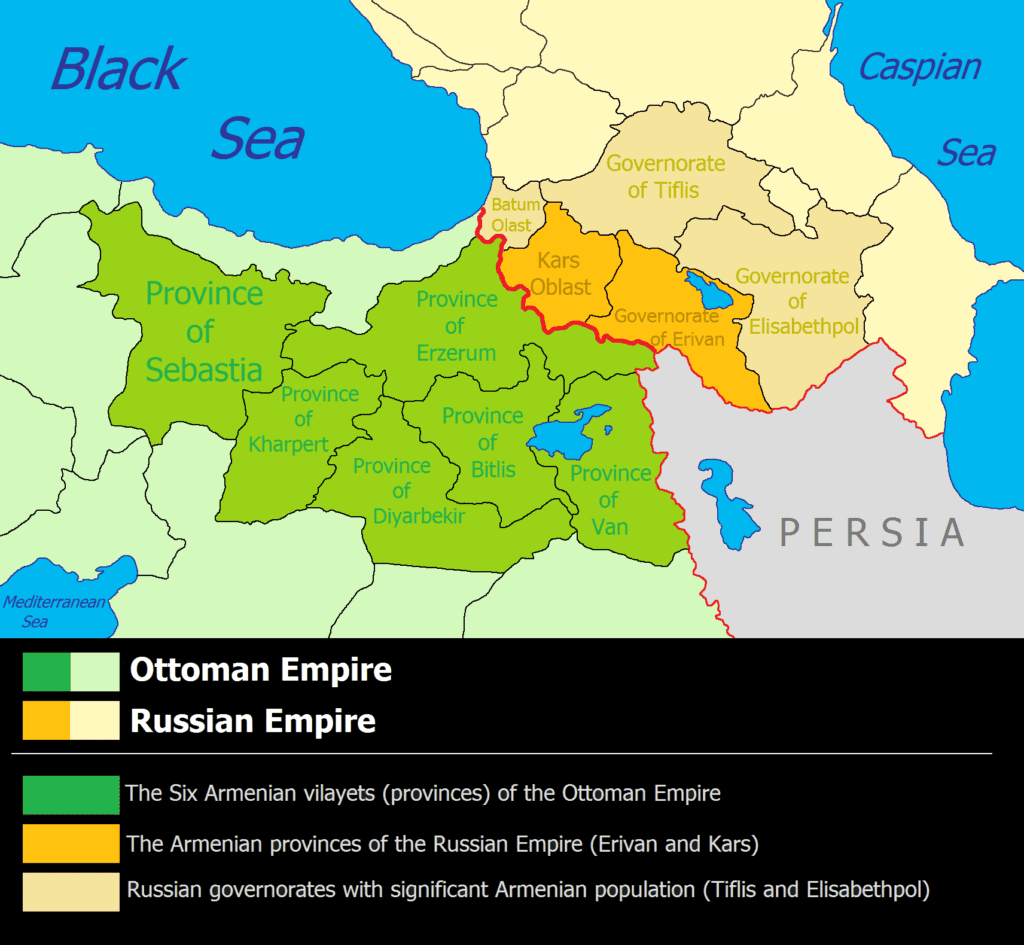
In 1915 when the genocide began, Armenia wasn’t its own country, but there was “Eastern Armenia” (which was part of the Russian Empire in 1915 and is parts of Armenia and Azerbaijan today) and “Western Armenia” (which was part of the Ottoman Empire in 1915 and is eastern Turkey today).
Armenia had been divided this way since 1639. You can see those two regions in the map above.
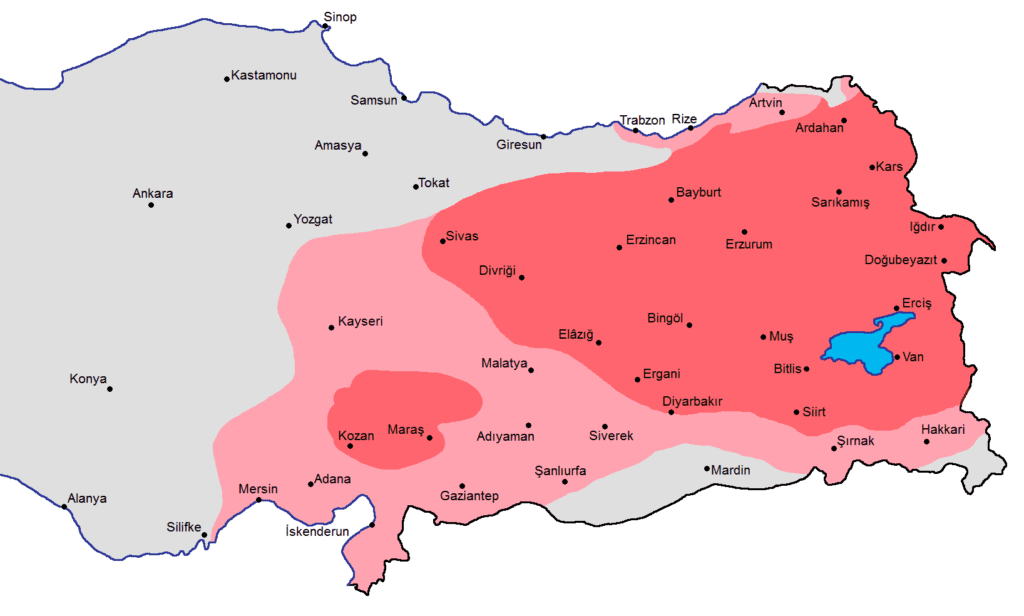
This map shows Western Armenia, also called Turkish Armenia or Ottoman Armenia, in 1915. The dark red areas were majority ethnic Armenian; the light red areas had significant Armenian populations. About three million Armenians lived in the Ottoman Empire in 1915, including 400,000 in Constantinople.
The Turks began massacring Armenians in Western Armenia in April 1915. It began with forced military conscription for able-bodied men in the city of Van, which the Armenians saw as tantamount to execution, and led to violence; on April 24, 1915, 200 Armenian intellectuals and community leaders in Constantinople were arrested, transported out of the city, and later executed.
One month later, the Ottoman government was authorized to deport anyone seen as a threat to national security; the Turks used this to kill Armenians, seize their property, and deport the survivors. Women, the elderly, and children were forced on death marches into the Syrian desert. Women and girls were raped continuously; many people starved or died of exhaustion.
Those who survived were held in concentration camps. Others were drowned, burned, or poisoned by physicians.
The word “genocide” was not coined until 1943 when writer Raphael Lemkin compared it to the Holocaust; until then, the Armenian Genocide was often called the Medz Yeghern or “Great Crime.”
The genocide led to Armenia’s diaspora. Today there are large Armenian populations in Russia, the United States, France, Argentina, and Lebanon, among other countries.
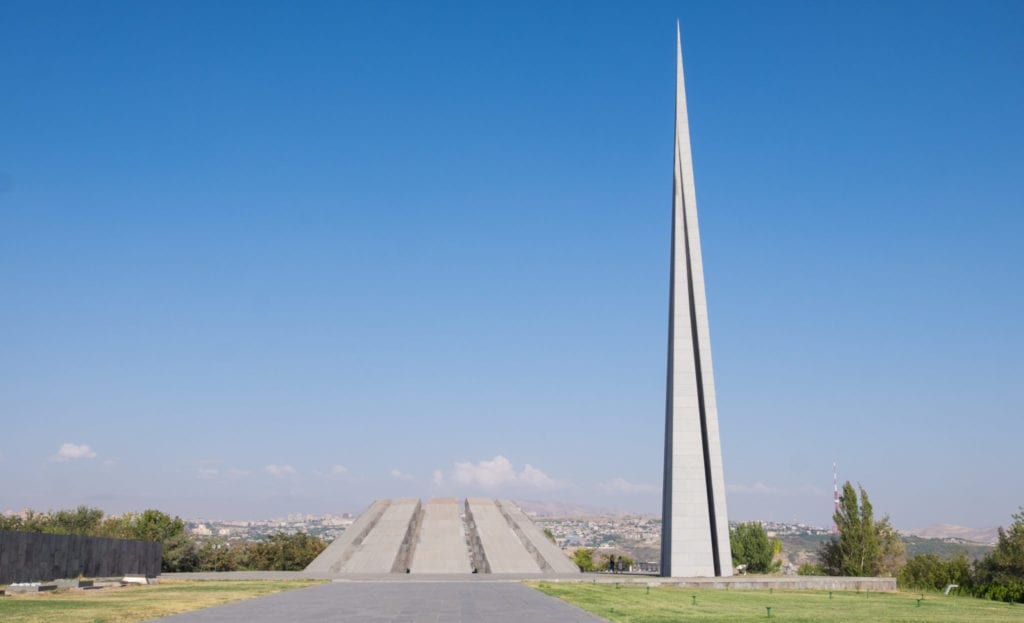
Walking through Armenia, surrounded by the progeny of survivors, the trauma is palpable — and I recognize this feeling. When I first visited Cambodia in 2010, you could feel the underlying current there, too. It was knowing that everyone over the age of 35 remembered the horrors of Pol Pot and the Khmer Rouge. It was seeing so many amputees and so few elderly people.
At least the world recognizes Cambodia’s pain. 100 years later, Armenia is still asking for validation.
Turkey refuses to acknowledge the Armenian Genocide. They deny it was genocide; they deny Armenians were targeted; they deny premeditation; they deny the death toll. While only Turkey and Azerbaijan actively deny the genocide, most nations neither affirm nor deny it.
What happens when you actually reckon with your past? Take Germany. Germans took many steps to acknowledge its horrific history and make sure that something like the Holocaust could never happen again. And it’s paid off — Germany is a strong country and European leader today because of it. Sure, they’ve got their right-wing fringe, as many countries do, but who could have imagined the Germany of today in 1945?
Compare that to the United States, where we still haven’t properly reckoned with the legacy of slavery. By sticking our collective heads in the sand, slavery never ended — it just changed form. From sharecropping to lynchings to Jim Crow to redlining to voter suppression to mass incarceration, black people are still held as second-class citizens in America.
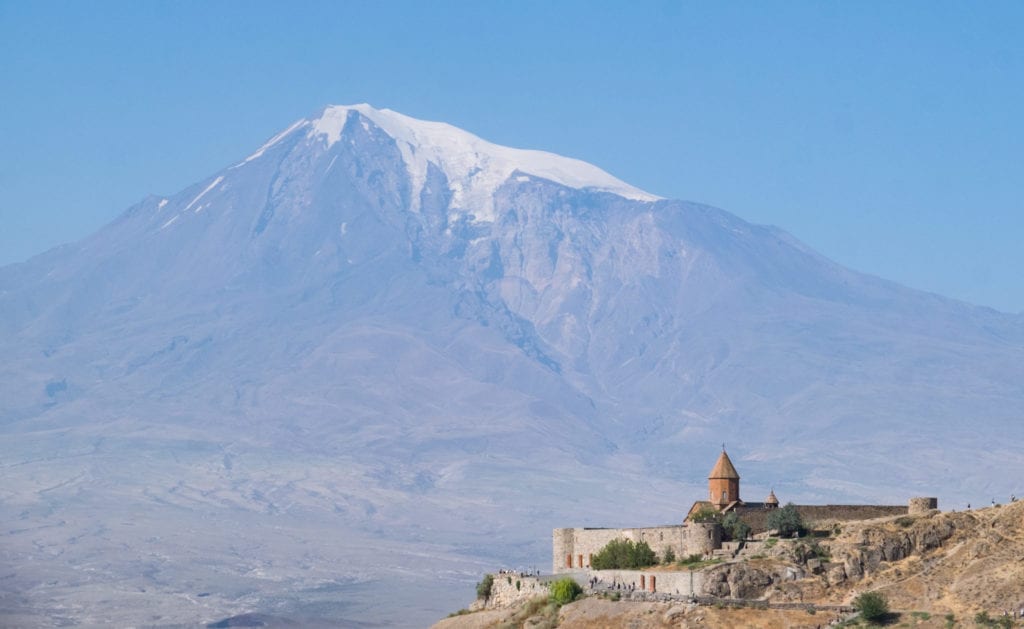
Mount Ararat is Armenia’s most beloved landmark. Ararat is a popular name for high-end Armenian brands. That image with Khor Virap monastery in front of Ararat is one of the most famous shots in Armenia. But just beyond the monastery is the border with Turkey — Mount Ararat rests within Turkish borders today.
Can you imagine the level of anguish that Armenians live with? The fact that your homeland’s beloved mountain is now within the borders of the country that murdered your people and continues to deny it to this day?
I can’t imagine living with it.
When I give talks about ethics in the travel blogging industry, one of my favorite examples to bring up is Kobe Bryant, who played for the Los Angeles Lakers. Bryant, who endorses many products, became an ambassador for Turkish Airlines in 2010. This was met with an uproar among his fans, as greater Los Angeles is home to 200,000 Armenians — the largest Armenian community in the United States.
That should have been obvious to Bryant’s management team — had they done basic research, they would have realized that Los Angeles’s most famous athlete partnering with the Turkish government would be anathemic to their community. But it’s not. This is what happens when atrocities go unrecognized. People don’t even realize.
The United States has not officially recognized the Armenian Genocide. President Obama said he would recognize it, but he never did. I’m choosing to believe he had a very good reason for that. However, things may be changing soon, as the House recently voted to recognize the Armenian Genocide with bipartisan support, 405 to 11.
As of press time, we’ll see whether McConnell chooses to bring it to a vote in the Senate. If it passes, Trump will likely veto it due to his relationship with Turkish President Erdogan; a 2/3 vote from Congress could override a veto. We’ll see. This is long overdue.
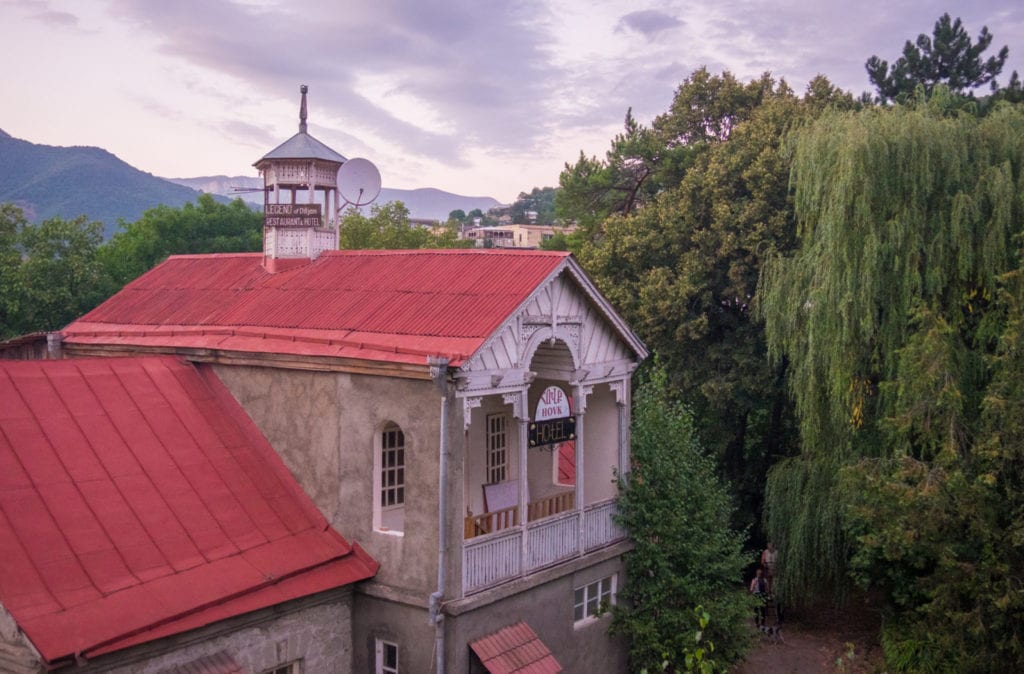
Armenia Travel
So if you’re planning a trip to Armenia, what’s it going to be like? To start, Armenia is in its early days of being a tourism destination. While tourism exists here, it’s nowhere on the level of most European countries.
If you’re traveling to Armenia after visiting Georgia, you’ll note the contrasts. Even though Georgia is relatively underdeveloped in the tourism space, it has a lot more visitors than Armenia.
Armenia travel is basic in many ways. There’s little infrastructure for tourists. Few businesses have their own websites; they primarily use Facebook. And much of the writing is only in Armenian, which has its own alphabet.
I traveled with JayWay Travel, a custom private tour operator specializing in Central and Eastern Europe, on a two-week journey through the Caucasus. This was not a solo trip; I traveled with my boyfriend for this part of the trip.
Five days of the trip were spent in Armenia and included three nights in Yerevan and two nights in Dilijan before driving back to Tbilisi. Armenia is a small enough country that you can see quite a bit while basing in these two cities.
Here are the highlights from my Armenia trip.
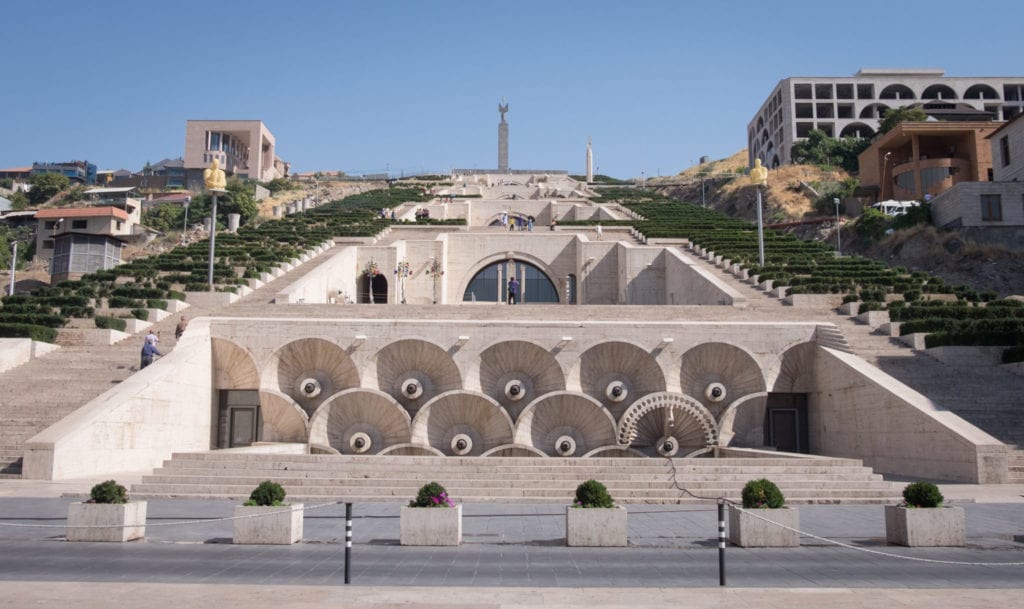
Yerevan
Without a doubt, Yerevan is the coolest city that I discovered this year. As much as I loved zany, chaotic Tbilisi, Yerevan felt so much more modern, more sleek, more put-together, more organized, more clean. The kind of place where I can put on a dress and heels for a casual day and fit right in.
Yerevan is filled with stately streets and parks. Cafes and restaurants dominate the sidewalks. Fountains explode during the day and are lit up at night. And it’s cheap and easy to get around by walking and the Yandex taxi app.
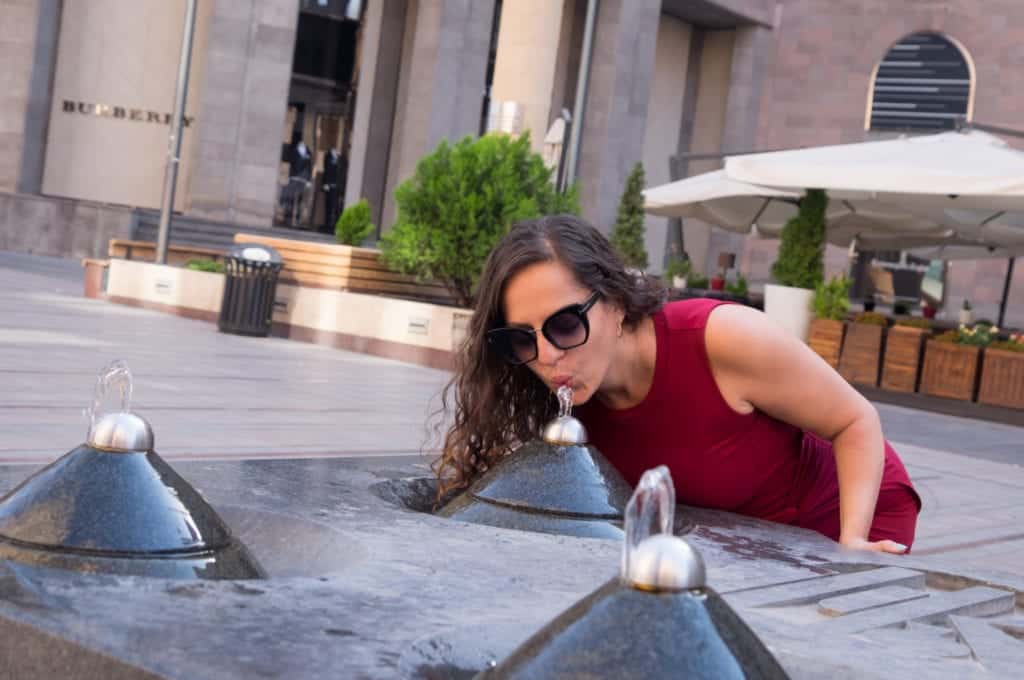
Armenia is a land of water — while neighboring Azerbaijan is a land of fire. The city is dotted with drinking fountains and the water is safe to drink — don’t forget to bring your reusable water bottle!
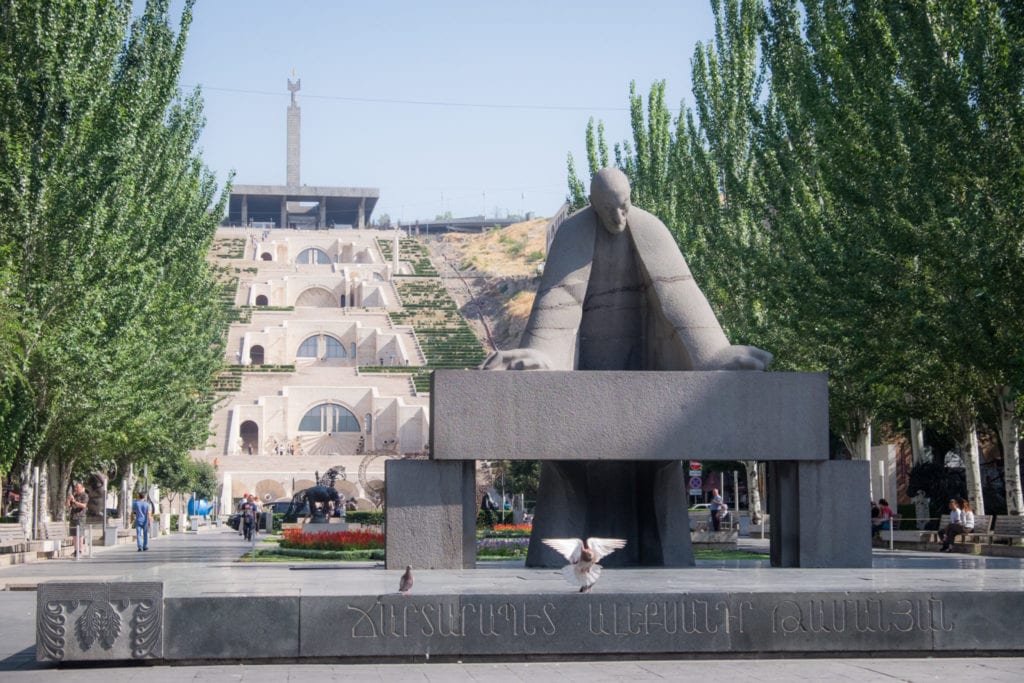
If you’ve seen any landmark of Yerevan, it’s probably the Cascade. This pyramid-like structure is filled with art installations and gathering spaces, and at night it lights up with fountains. It’s the place to see and be seen, whether you’re a teenager with your friends or out on a date with someone special!
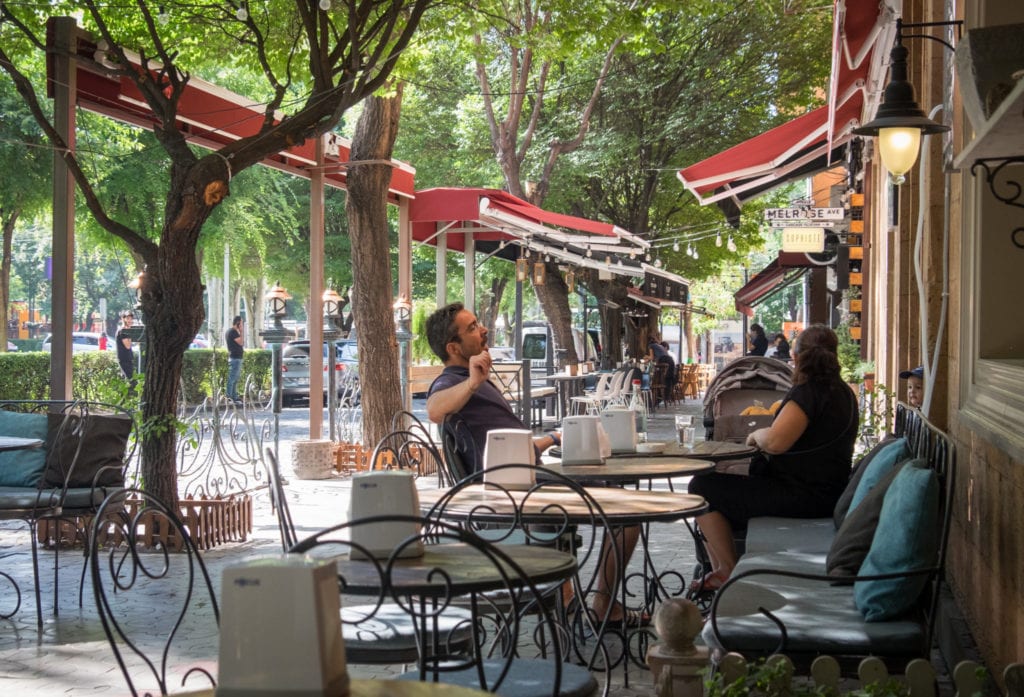
I love a city that’s filled with cafes — and Yerevan has so many of them! Try a lemonade with sea buckthorn, it’s an unusually tart taste.

Yerevan has been celebrating its 2800-year anniversary. That puts it on par with ancient Rome.
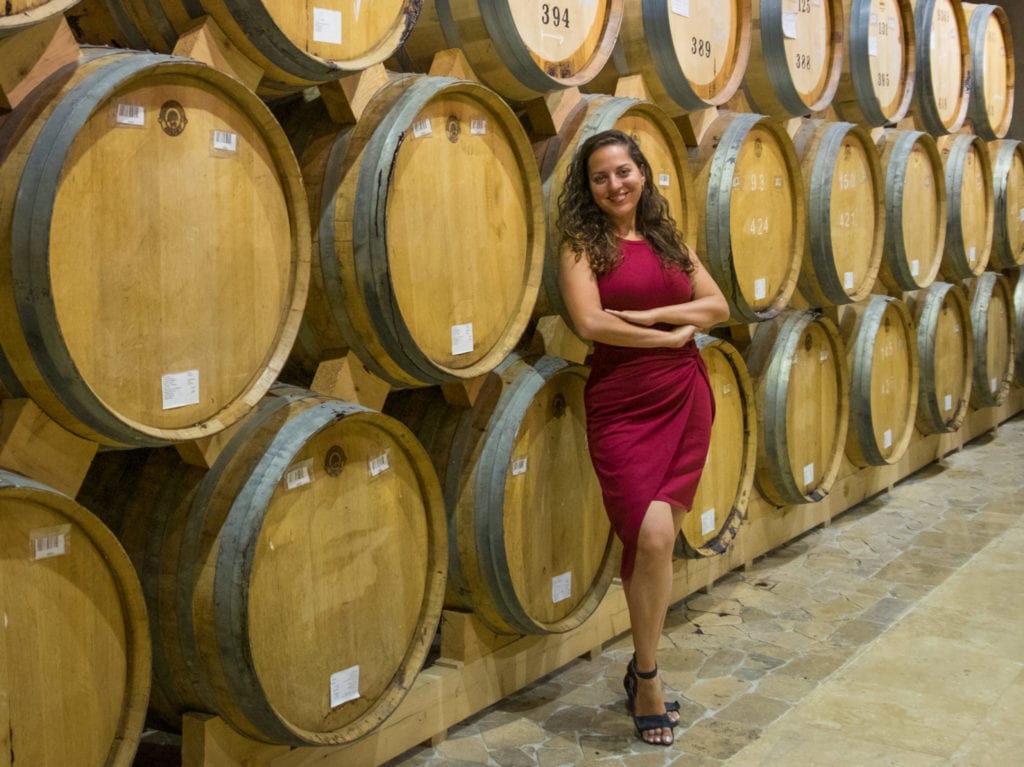
Did you know that brandy is huge in Armenia? Ararat is the high-end brandy of Armenia and you can visit the Ararat Factory and do a tasting. This was a lot of fun!
(Also, it turns out that brandy is to Cognac as sparkling white wine is to Champagne. Same product, different production region.)
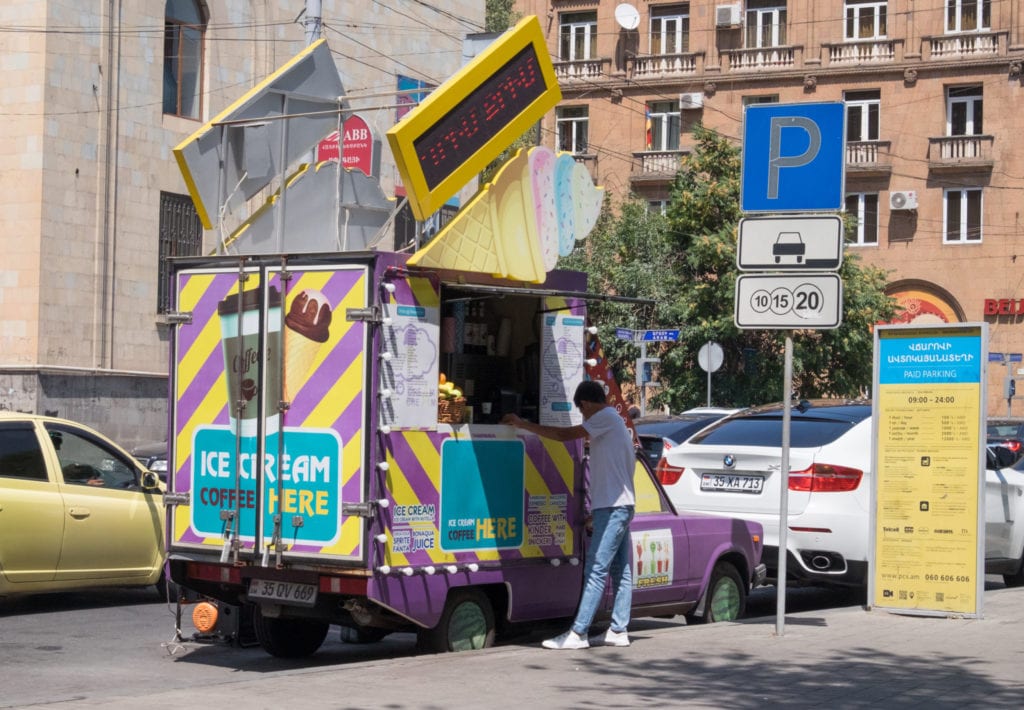
The first thing that I noticed when I got to Yerevan? All the food trucks! There was actually a taco truck outside my hotel! Do you know how much I crave tacos while traveling?!
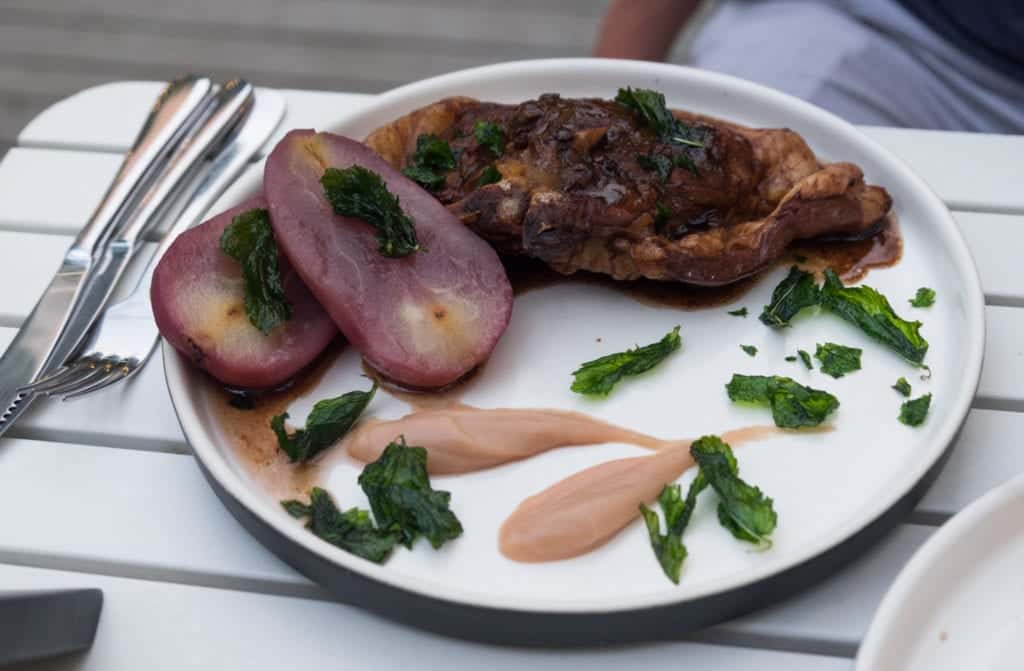
One of my favorite restaurants in Yerevan was Gouroo Club and Garden. It’s an idyllic outdoor setting underneath strings of lights. The food is international, not Armenian, but we had some fabulous dishes like this barbecued lamb with poached pears.
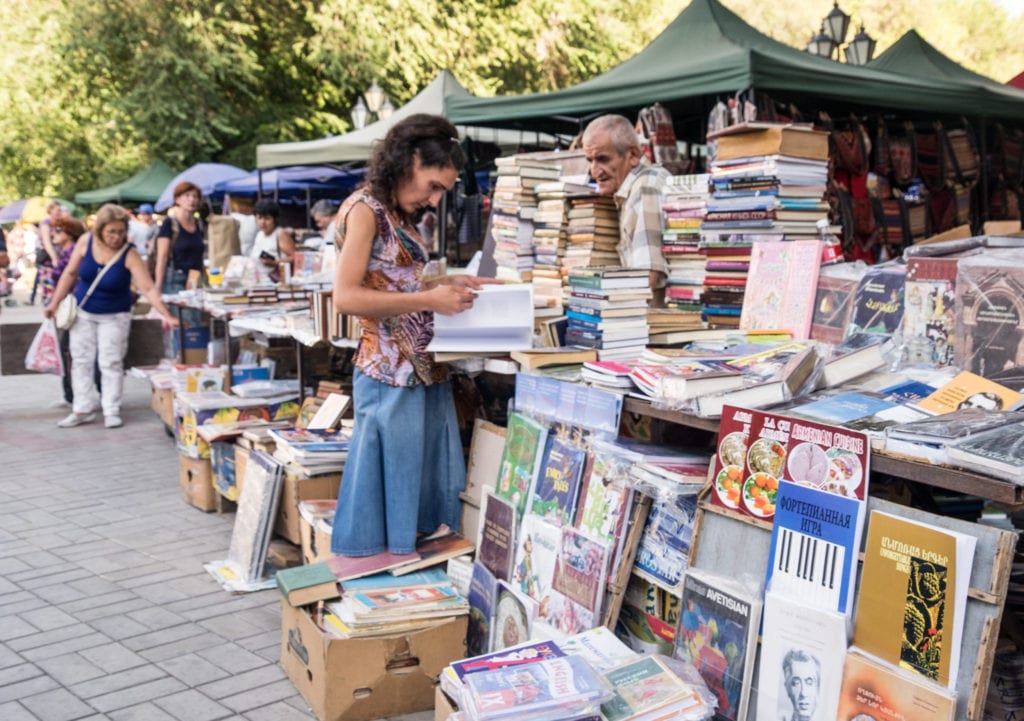
The Vernissage is an outdoor street market in Yerevan. There were lots of interesting things for sale — I especially loved the intricate chess boards.
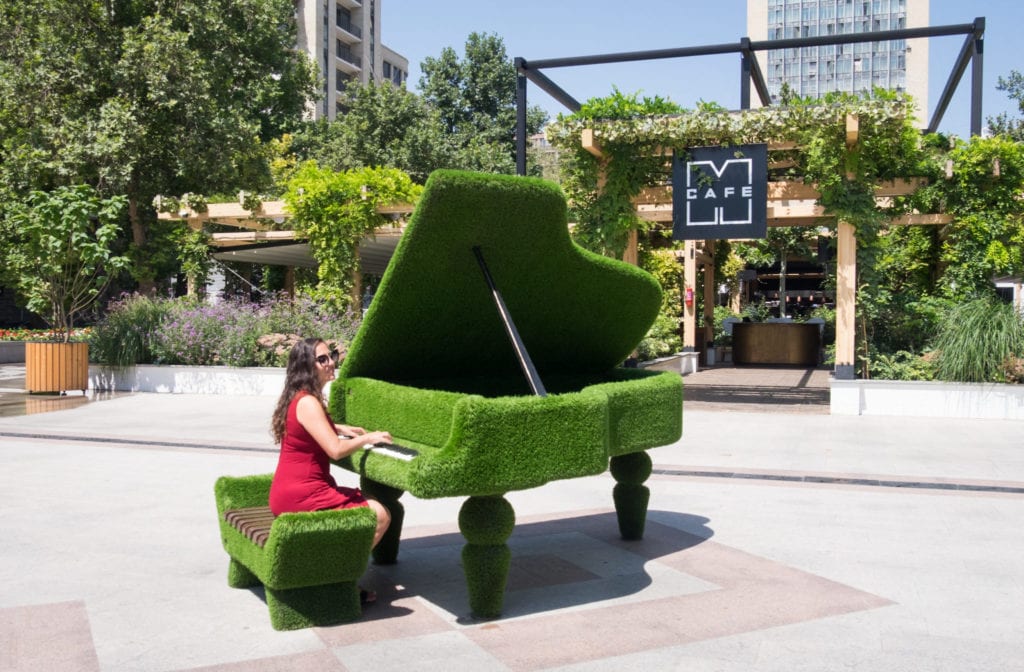
And you can totally play a grass piano! (Definitely not a real piano.)
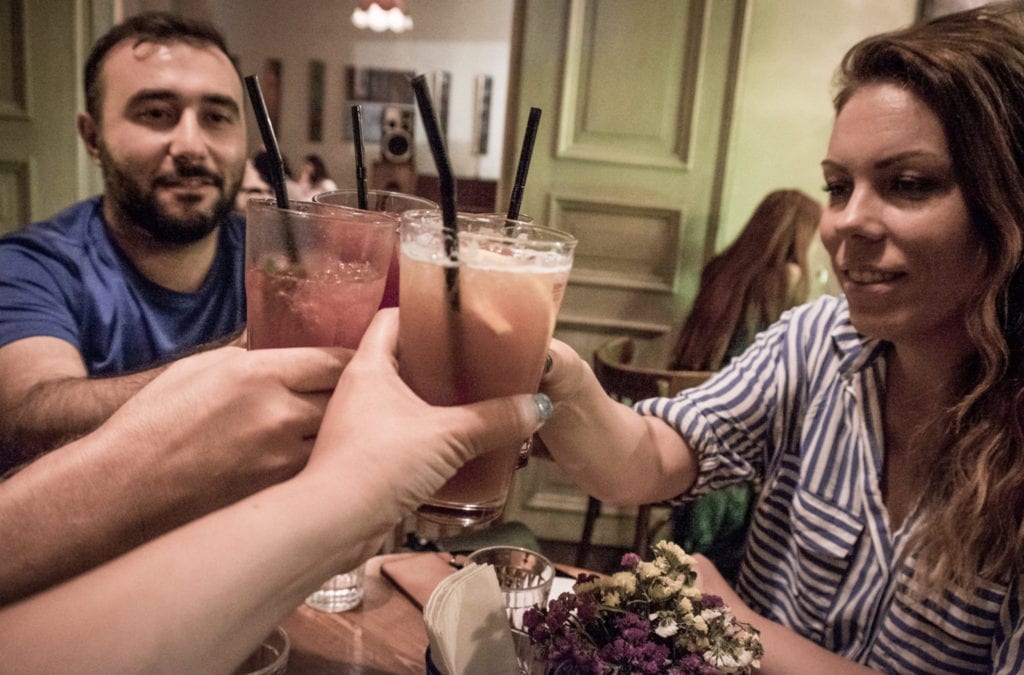
But where Yerevan truly comes to life is at night. With so many outdoor cafes and restaurants, I got a lot of Southern California vibes. Maybe the Armenian-Americans are bringing that from LA! I loved the outdoor scene so much that I would recommend visiting Yerevan in the summer if you can.
Yerevan makes a good base for several days, as you can easily day trip to the surrounding sights. Or perhaps even longer. I enjoyed Yerevan so much, I’d totally spend a month there!
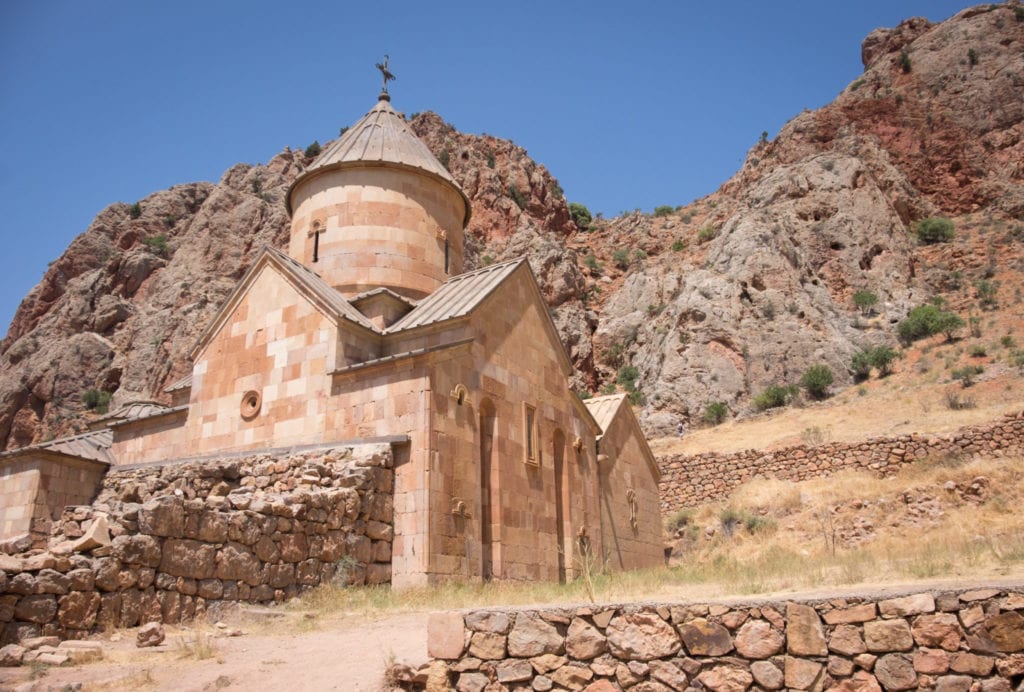
Armenian Monasteries
There are a lot of spectacular monasteries around Armenia. And while they’re some of Armenia’s top cultural treasures, I warn you that monastery fatigue is real. If you visit a ton, they’re going to start to blur together.
For that reason, I would prioritize the best ones: Khor Virap, Noravank, Geghard, and possibly Tatev, depending on your schedule.
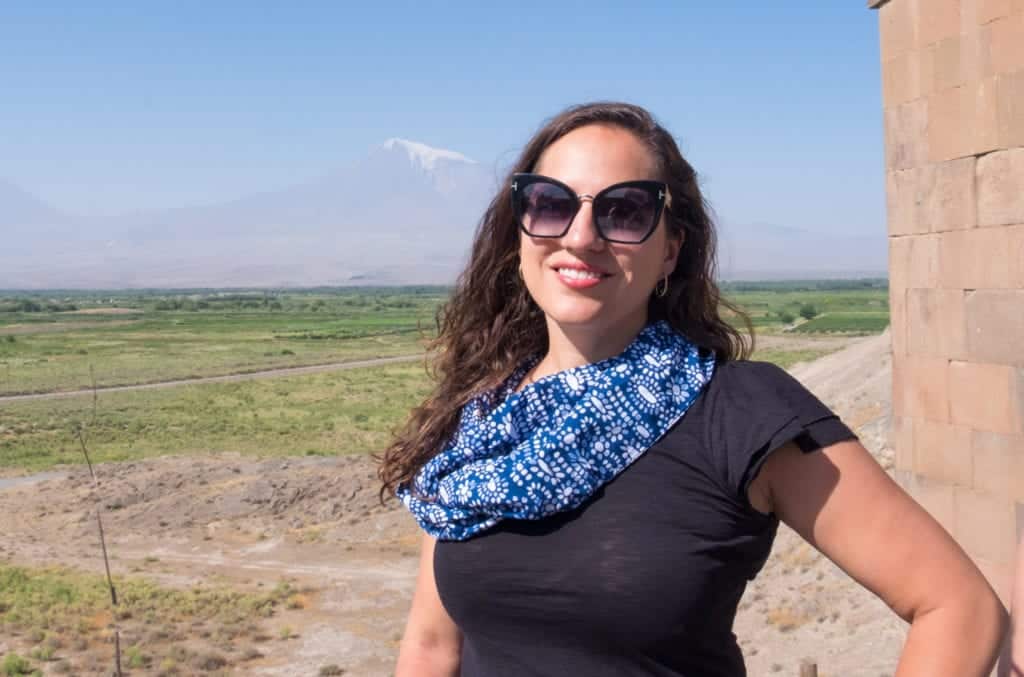
On the way to Khor Virap, you see that spectacular viewpoint with Mount Ararat in the background. That photo is earlier in this post; here’s a photo of me and the mountain and the Turkish border. That photo alone makes Khor Virap a must-see.
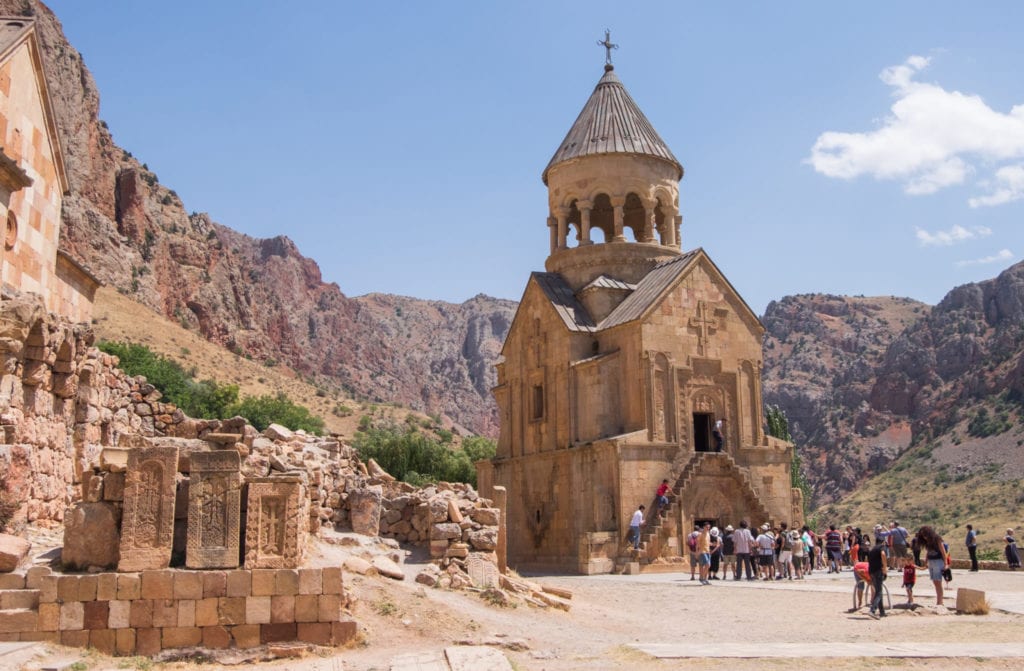
Noravank is a spectacular monastery not too far of a drive from Khor Virap. When you see this monastery, you actually drive into a canyon. It’s a spectacular sight, seeing the sand-colored monasteries up against the canyon. There’s a cool staircase into the monastery, too.
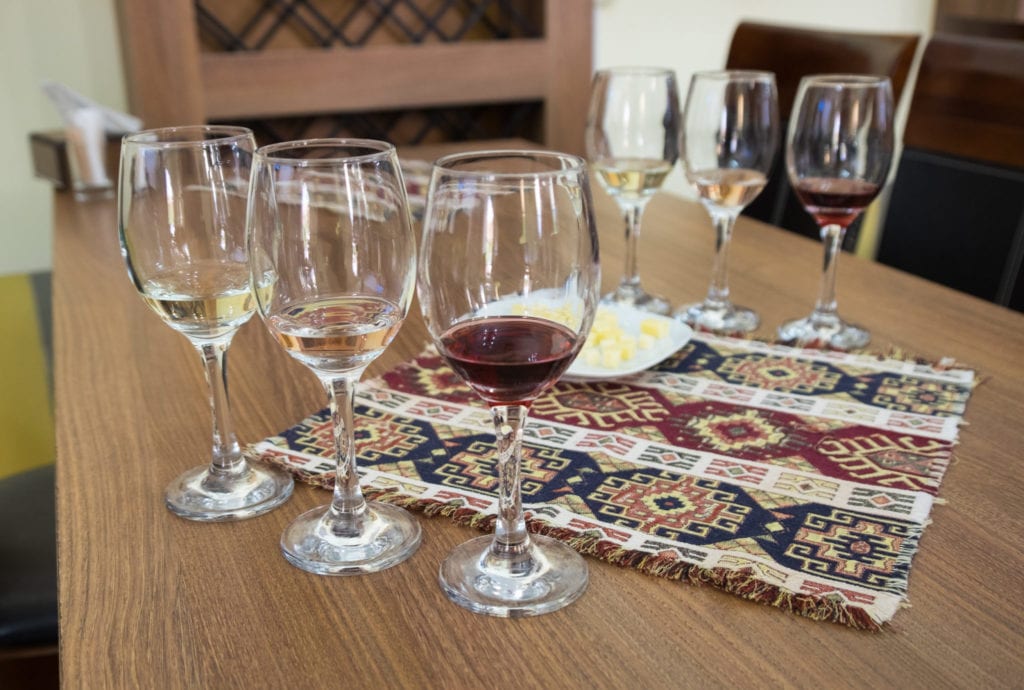
And if you visit Noravank, you can do some wine tasting in the nearby town of Areni. Armenian wines aren’t well known internationally, but they’re delicious!
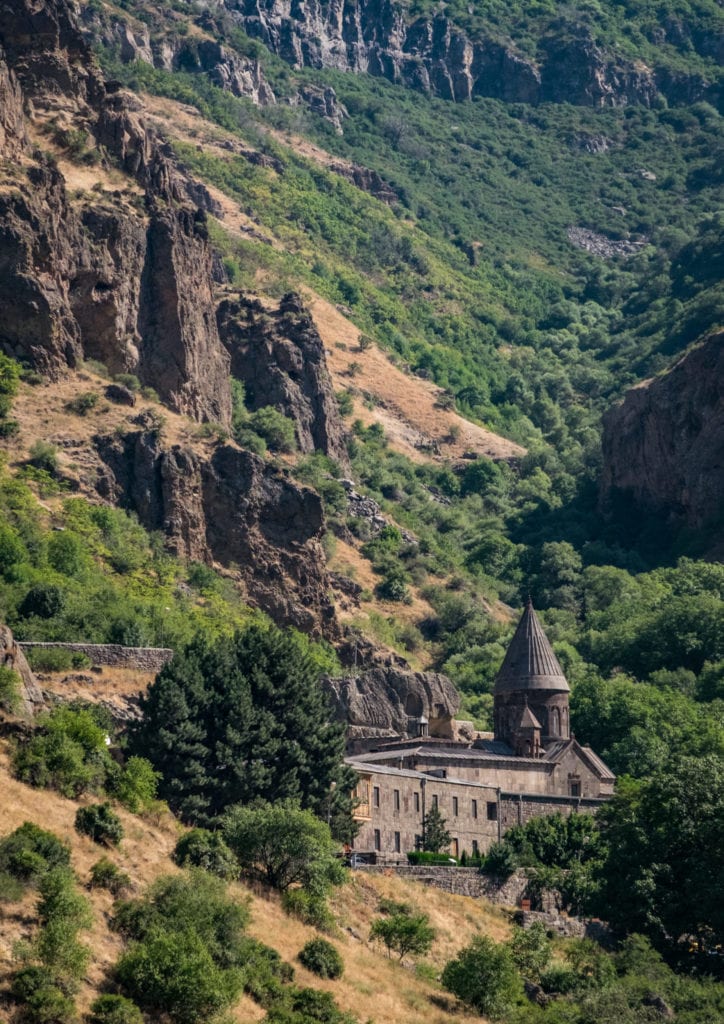
But of all the settings, Geghard Monastery is placed in the most spectacular environment of all. One of Armenia’s UNESCO World Heritage Sites, Geghard Monastery is set in a canyon, surrounded by dark brown rocks and lush green vegetation. It almost looks like it grew naturally in the shape of a church.
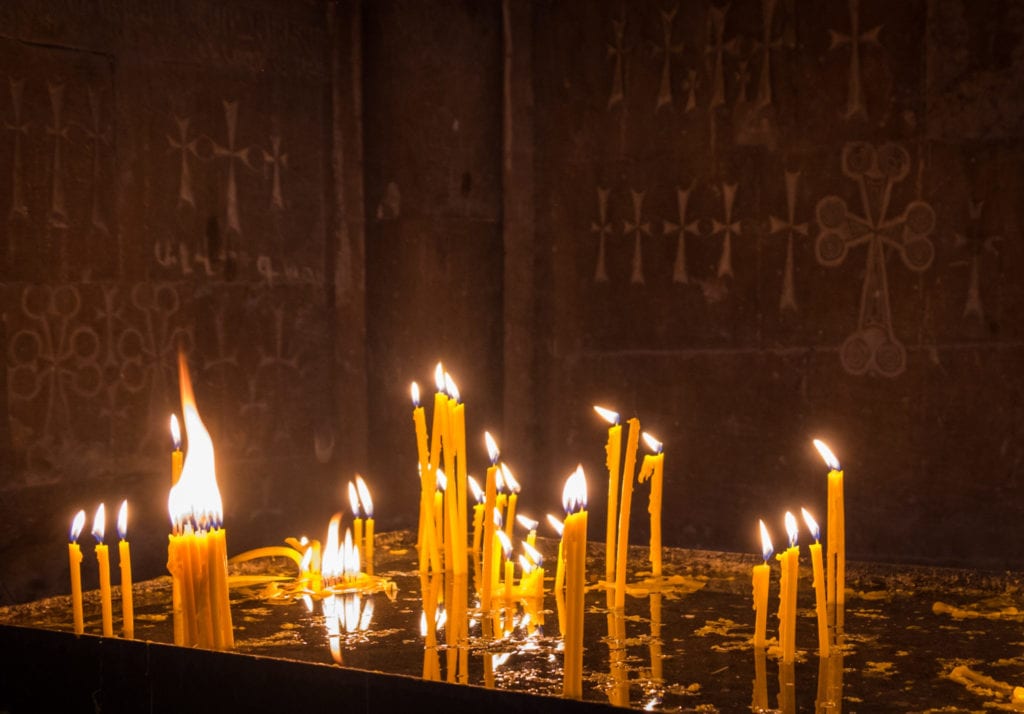
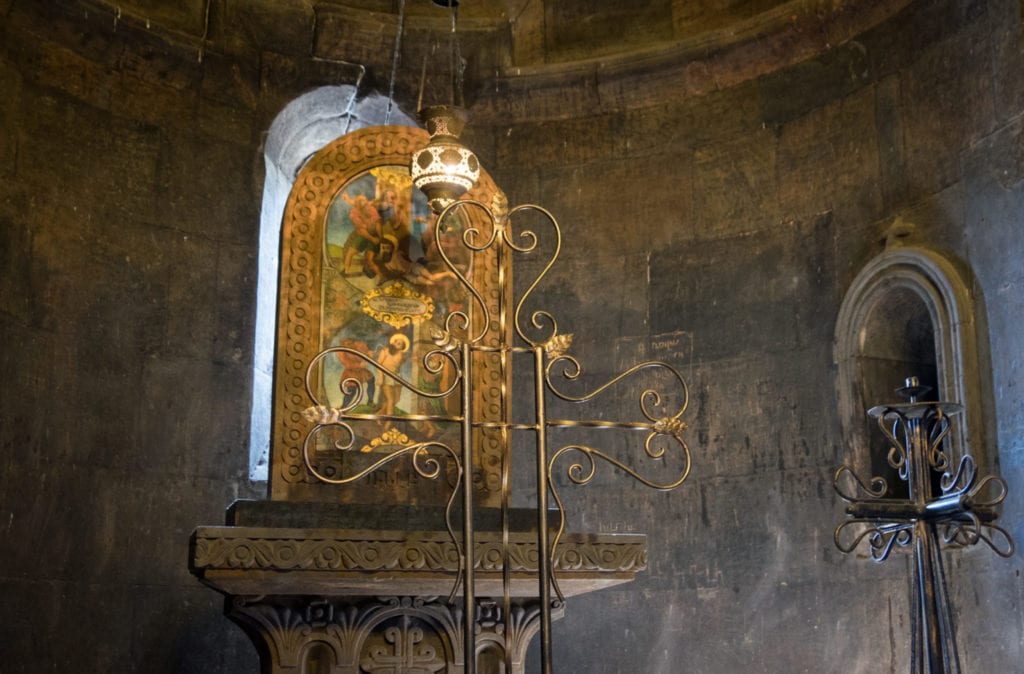
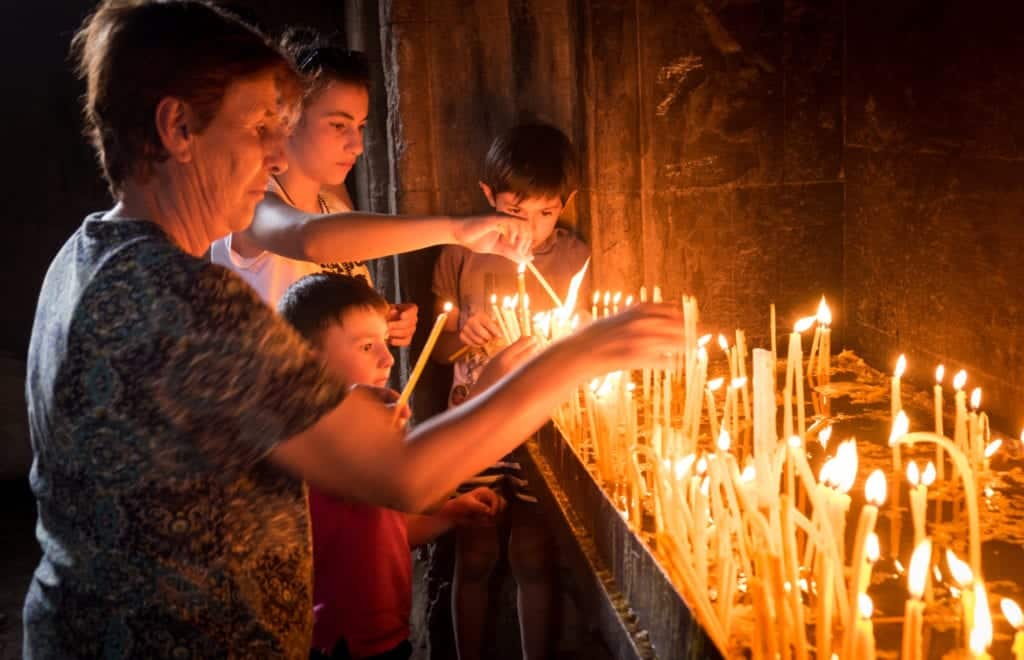
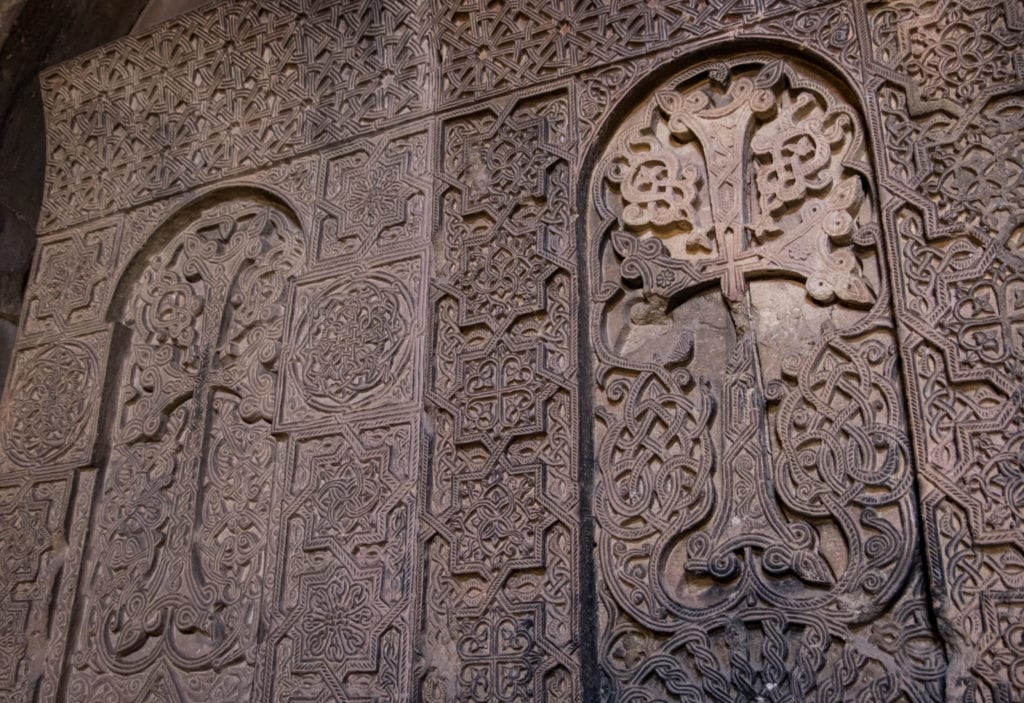
As you can see, many of the interiors look similar — cross carvings, candles, gold leaf art.
In Geghard Monastery we were lucky to be there when five women performed sacred music, their voices like angels. Listen to the video above; it’s astounding.
Another option is Tatev Monastery, in the far southeast of Armenia. It’s about a 4.5 hour drive from Yerevan, making it too far for a day trip. While I didn’t visit Tatev on my trip, I’ve heard it’s one of the best.
Many people visiting Artsakh, the Armenia-occupied region of Azerbaijan also known as Nagorno-Karabakh, stop at Tatev Monastery and often overnight in the nearby town of Goris.
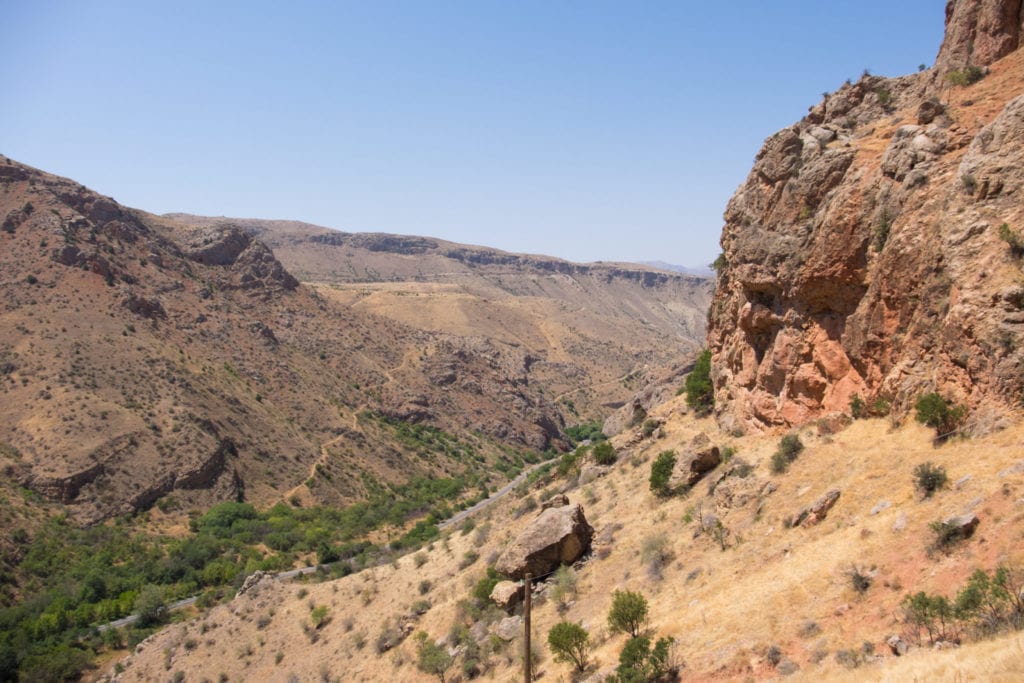
Insane, diverse landscapes
What struck me the most about Armenia is that there’s so much geographic diversity packed into a relatively small country!
This bright orange canyon is the view from Noravank Monastery.
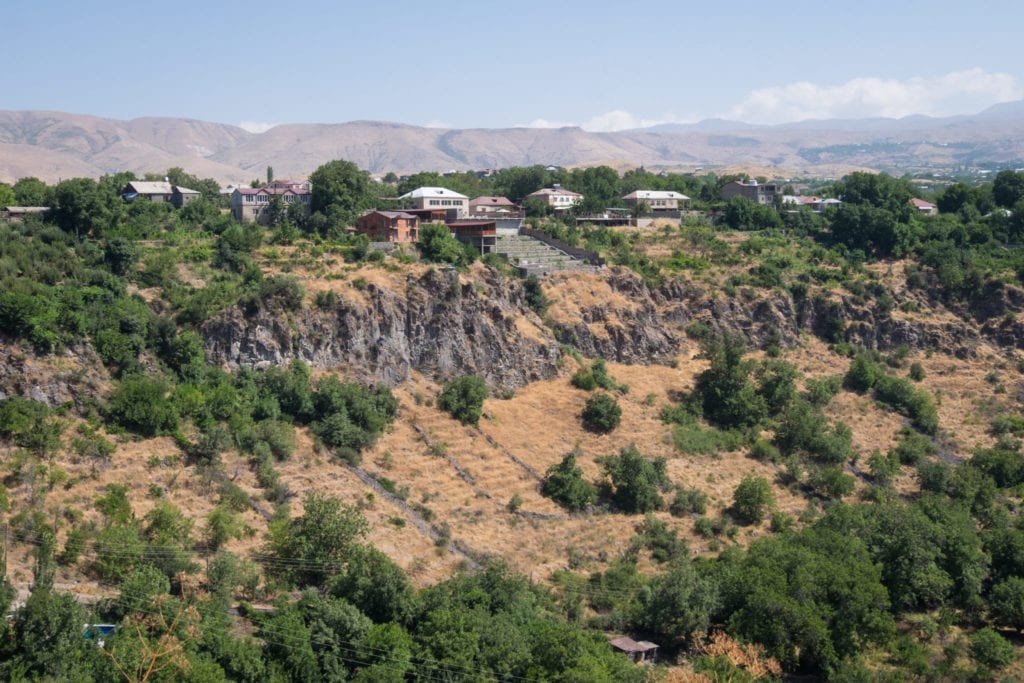
Many of Yerevan’s elite own homes on the edge of cliffs close to Garni Temple. If I had to choose a spectacular setting, this one is up there.
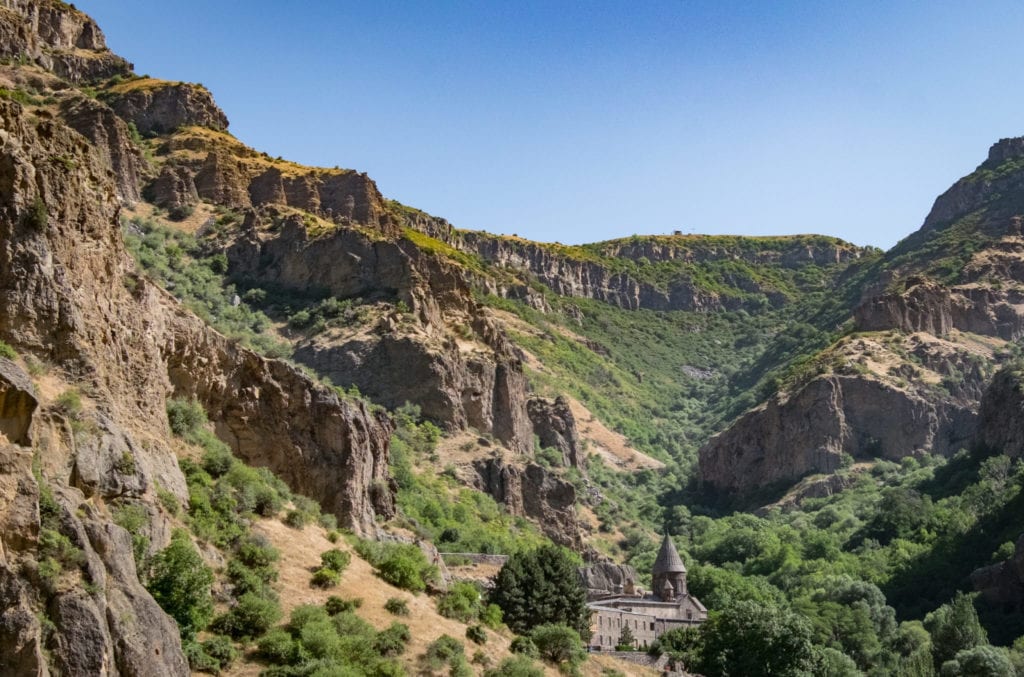
Once you zoom out from Geghard Monastery, you can see just how spectacular the views are.
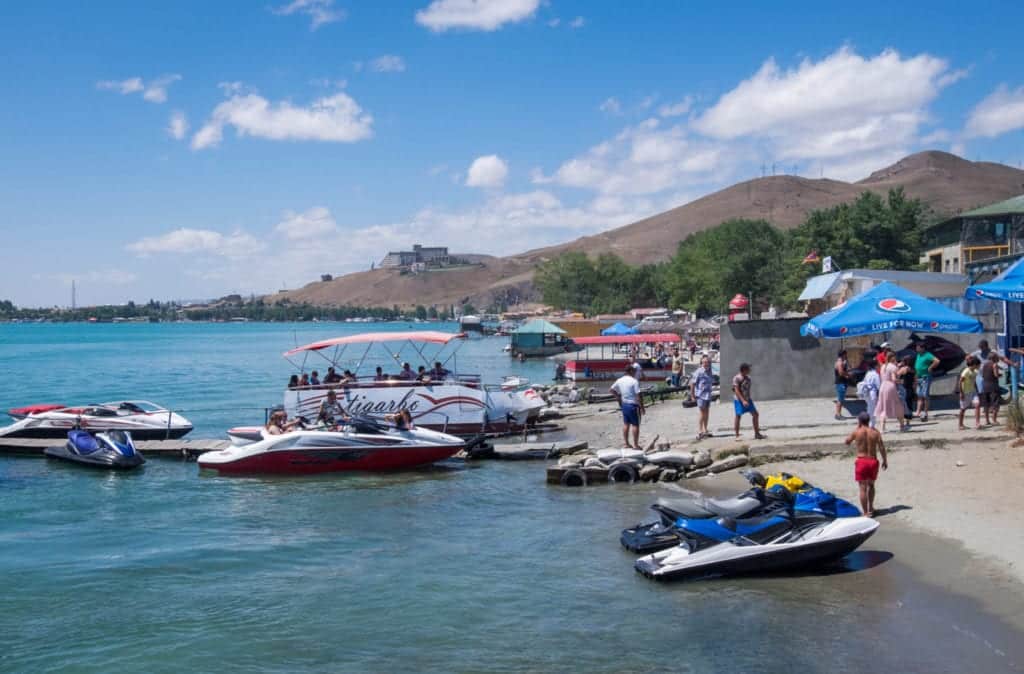
Armenia even has its own version of the seaside. While it’s a landlocked country, just an hour’s drive from Yerevan is Lake Sevan! Here you can enjoy some of the country’s best seafood (I actually tried a crayfish kebab) and enjoy the views from the monastery above the lake.
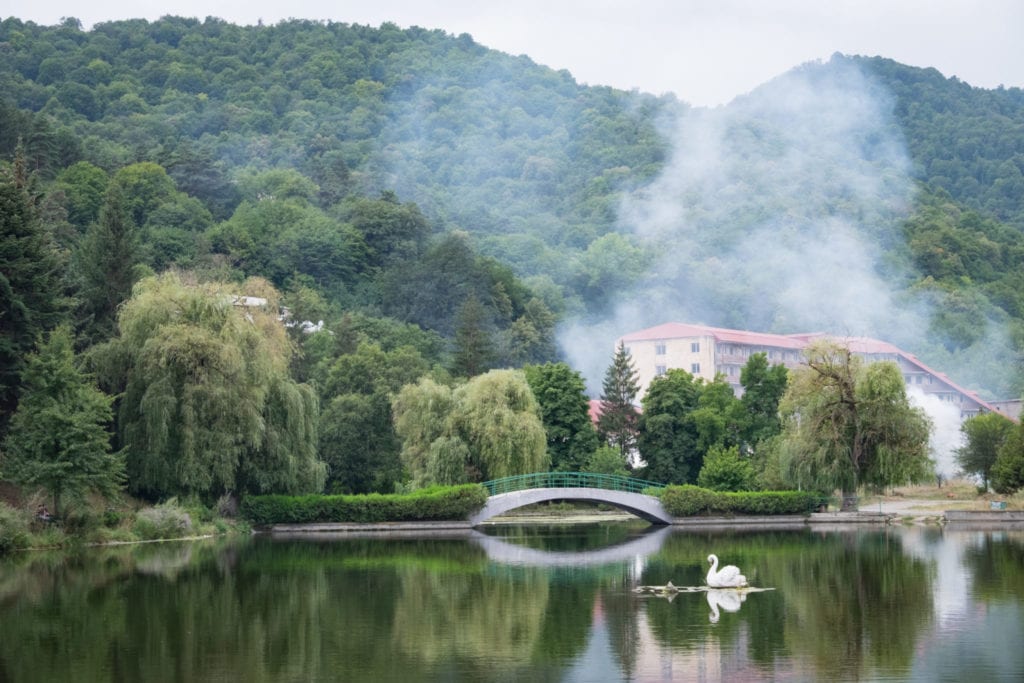
Dilijan
Dilijan refers to itself as “Armenian Switzerland” — it’s a community up in the mountains filled with traditional wooden homes. While the peaks up here aren’t quite as dramatic as the Jungfrau, it’s a beautiful region and feels different from the rest of Armenia.
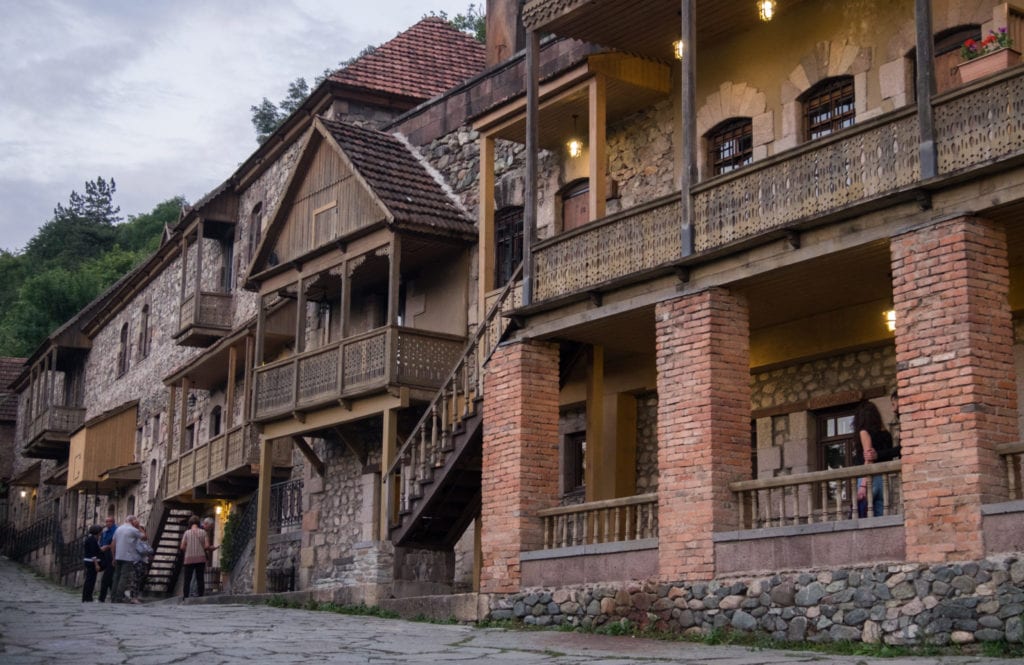
Lots of people who travel to Dilijan like to spend their days hiking, exploring the lakes, and seeing (even more!) monasteries. I had a free day and frankly, by this point in my travels I needed a day of staying still. Good thing Dilijan is a good place to hang out.
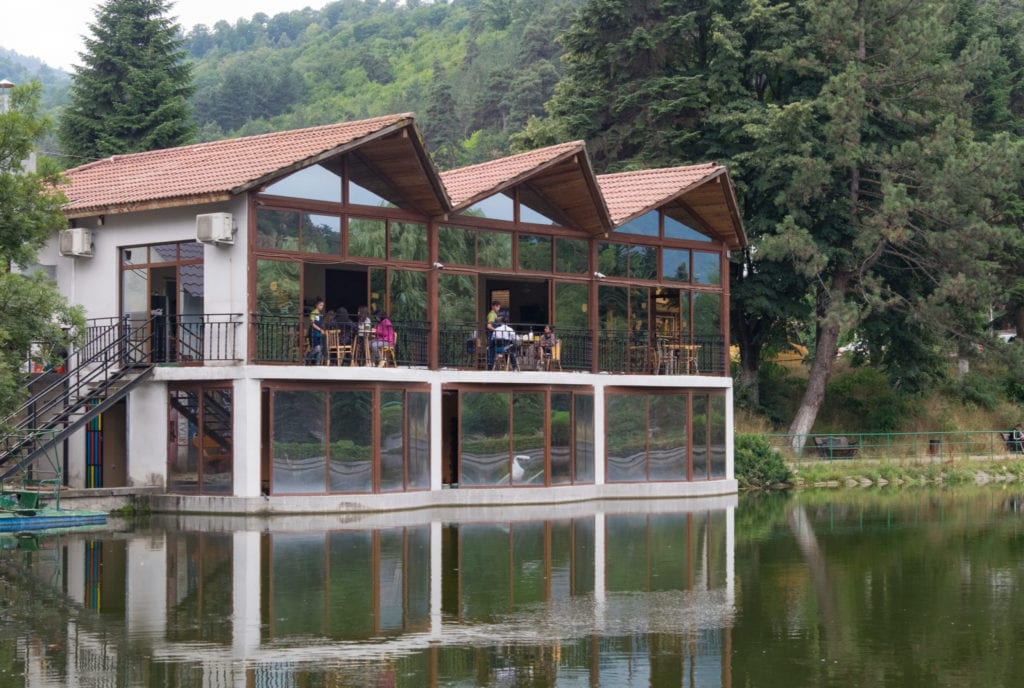
On the recommendation of our guide Karen, we stopped at Cafe Number Two, a lovely cafe on the lake with good coffee and food. This cafe trains teenagers to work in Armenia’s burgeoning hospitality industry. I’m always happy to support an establishment like that!
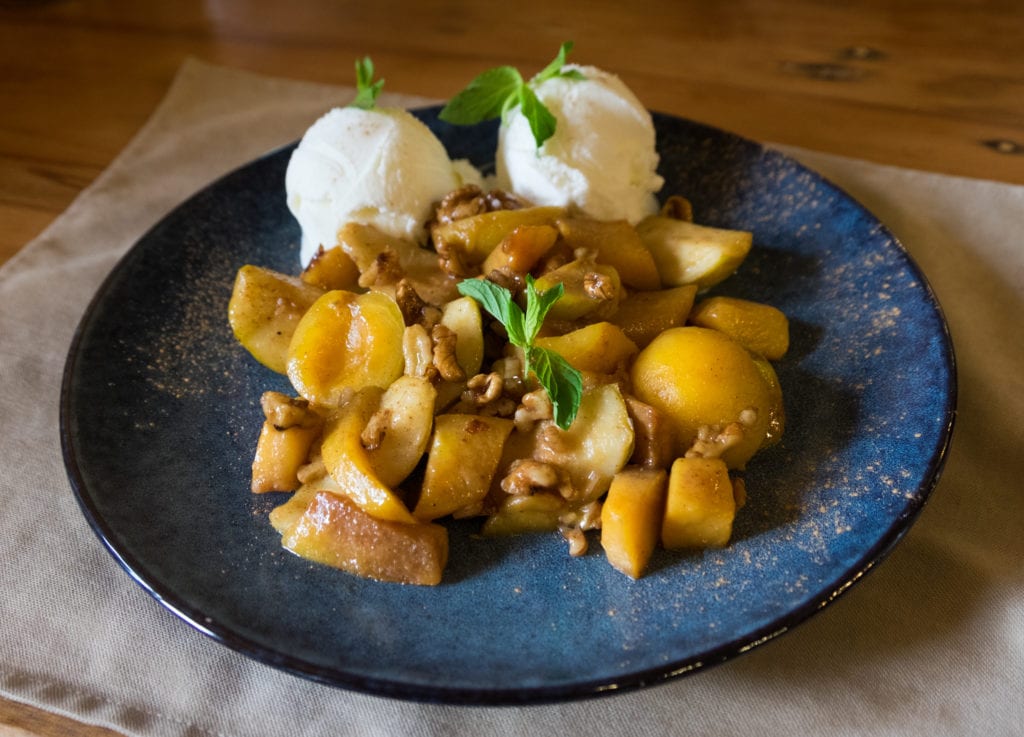
One of the big food highlights was Papanino House, where we were each surprised with a dessert, courtesy of the chef. (No idea why — we went here randomly. Maybe because I shared it on Instagram?) Pears, apricots, and walnuts, sautéed in butter, cinnamon and sugar and served with vanilla ice cream.
Another culinary highlight was the Flying Ostrich by Dolmama, where I enjoyed a hot cherry soup with walnuts that toed the line between sweet and savory. I don’t think I’ve had cherry soup since Hungary in 2004!

Armenian Food
What is Armenian food, anyway? Even here in New York, it’s hard to find a straight Armenian restaurant — so many of them are Armenian-Lebanese and lean on the latter cuisine.
Armenian food is fresh, delicious, and they know their way around an herb garden! A lot of Armenian dishes are similar to Georgian cuisine, especially the stews, but I found Armenian flavors to be more gentle. Georgian food is about as subtle as a sledgehammer; Armenian food realizes that less can be more.
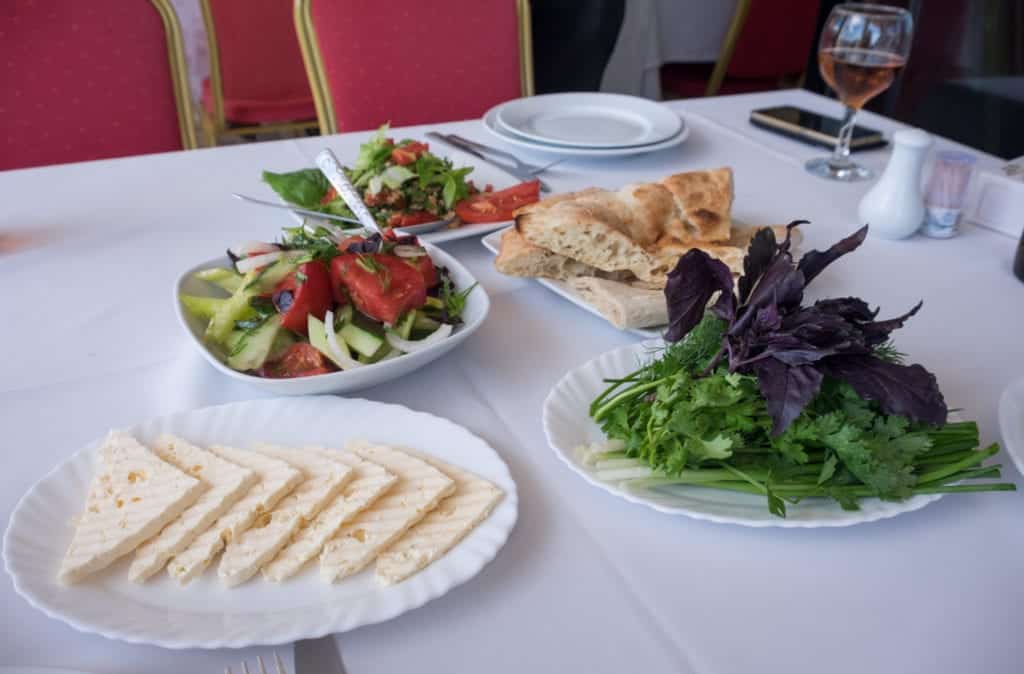
My favorite Armenian dish? The bread. Honestly. One popular thing to do is have bread and you fill it with accoutrements — I loved it with matsoni (thick, strained yogurt), cheese, and herbs — usually purple basil, dill, and cilantro, occasionally chives or green onions.
It sounds so simple, but it’s SO delicious. The absolute best bread I had was at a restaurant called Temurnots, right near the Cascade in Yerevan, a recommendation from my friends Megan and Aram.
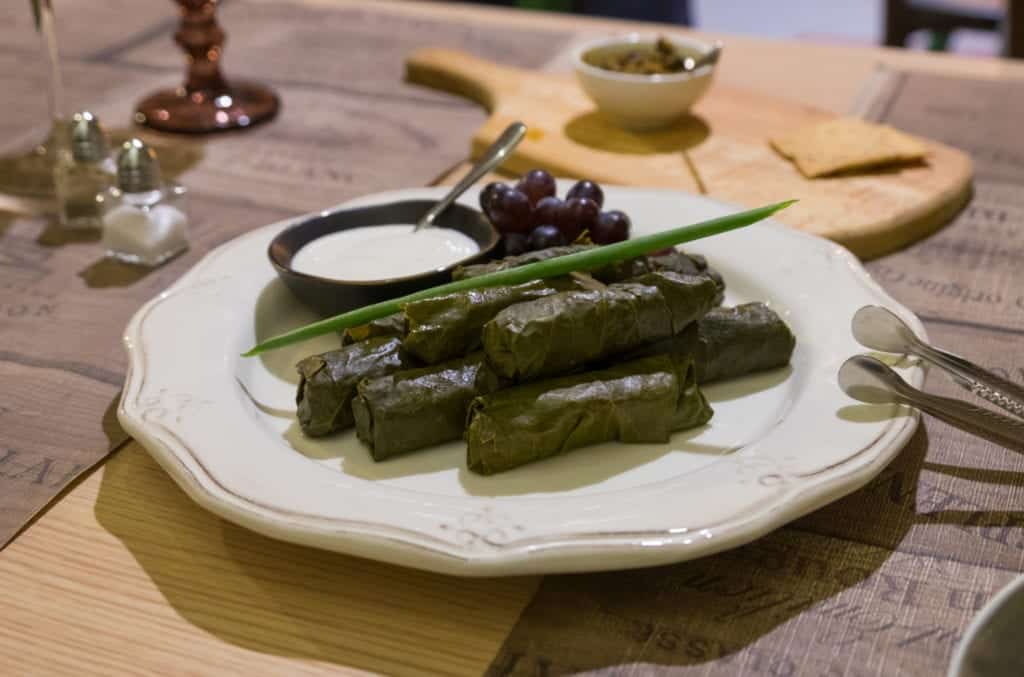
These dolma, or stuffed grape leaves, were outstanding. While you can have dolma in lots of countries, Armenia had some of the best dolma I’ve ever had.
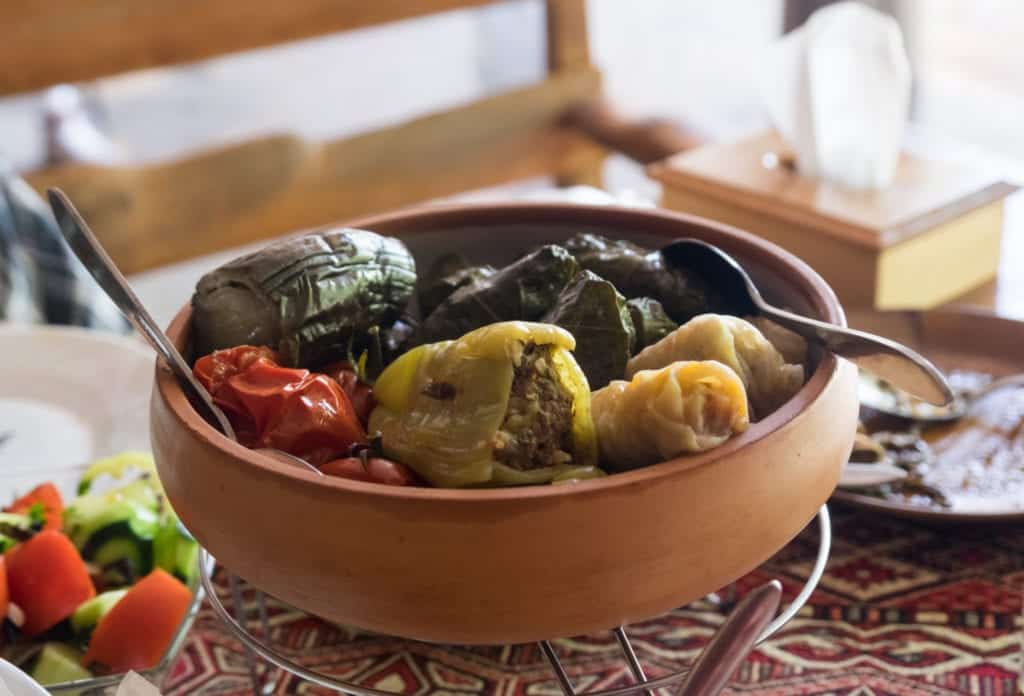
Dolma can also refer to stuffed vegetables, like these stuffed peppers.
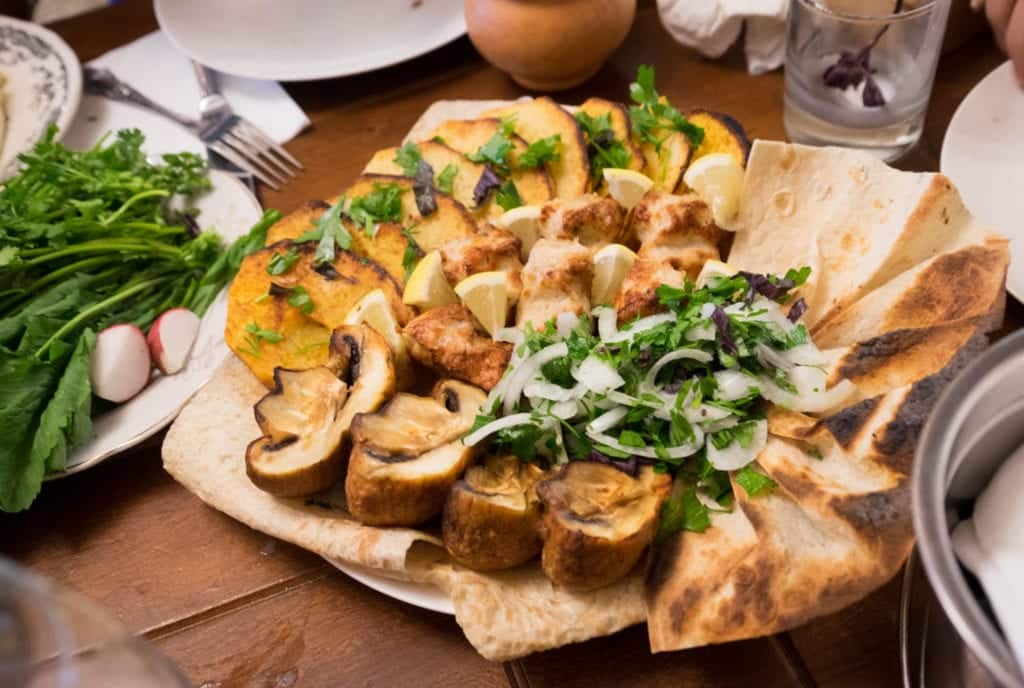
Grilled potatoes. Fresh mushrooms. Roasted chicken. Lots of bread. Tons of goodness, served alongside fresh herbs.
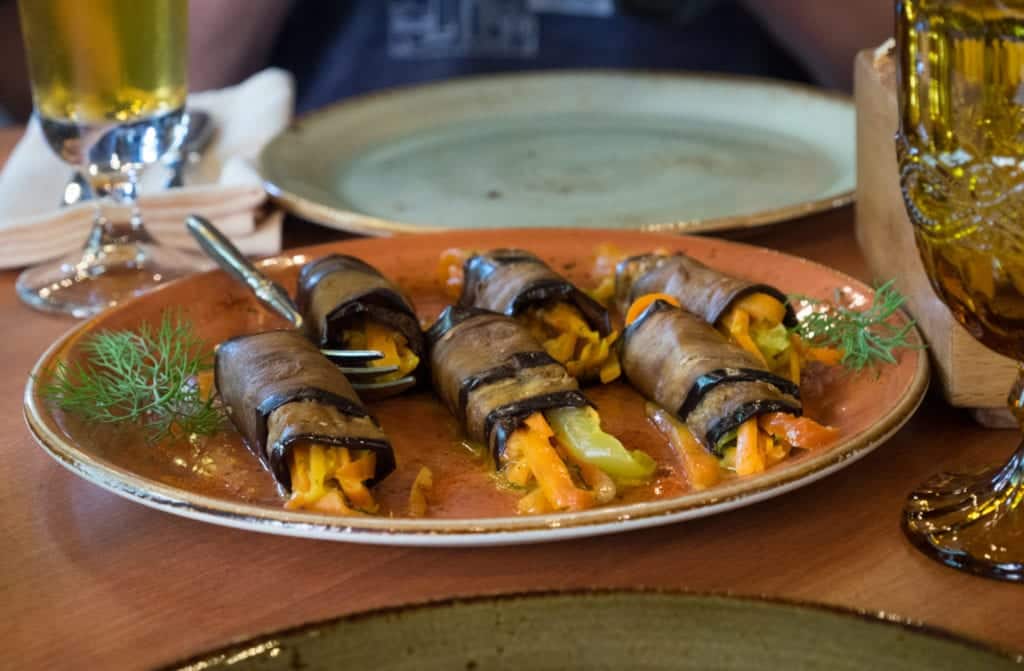
Armenia is a great country for vegetarians — there were vegetarian options on every menu! These eggplant rolls were stuffed with carrots and bell peppers.
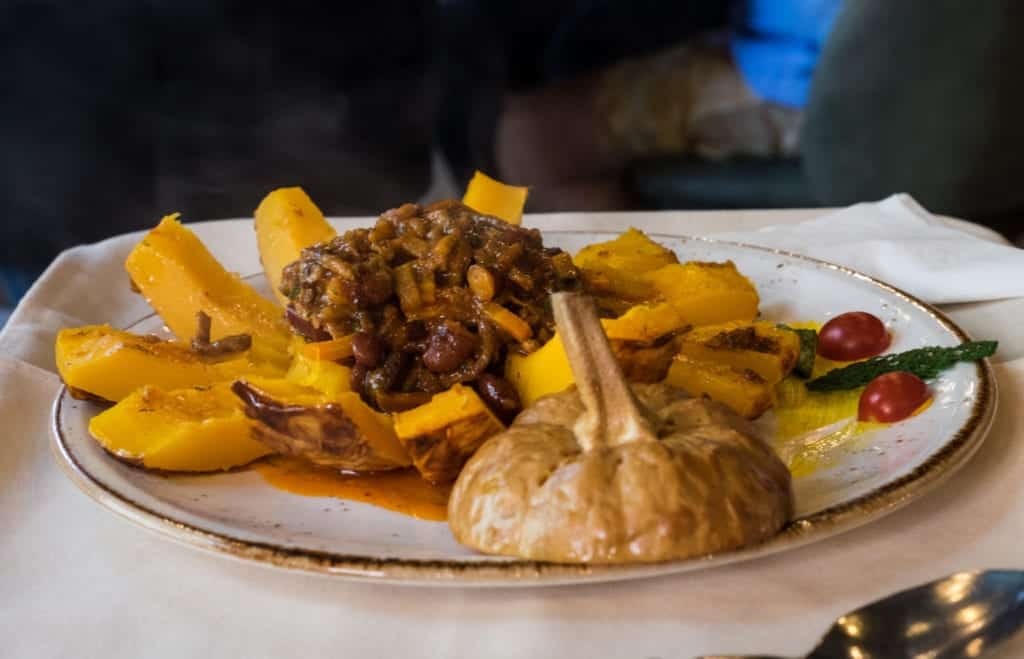
If you’re looking for a showstopper of a dish, try ghapama — a pumpkin filled with cooked rice, fruit, and nuts. This version was a Ghapama Erzrum, filled with beef, kidney beans, and vegetables.
This one was at Sherep, one of the top recommended restaurants in Yerevan (and one that I recommend). It was pure theater when the server cut the pumpkin into a star!
Another thing — I was stunned to hear, “Smoking or non-smoking?” as I entered Sherep. It seems like everywhere in the world is now either nonsmoking or smoking-friendly — I thought we had all given up on the fallacy that smoking sections in restaurants are effective. Well, good news: thanks to a new law, Yerevan’s restaurants will be smoke-free within a few months.
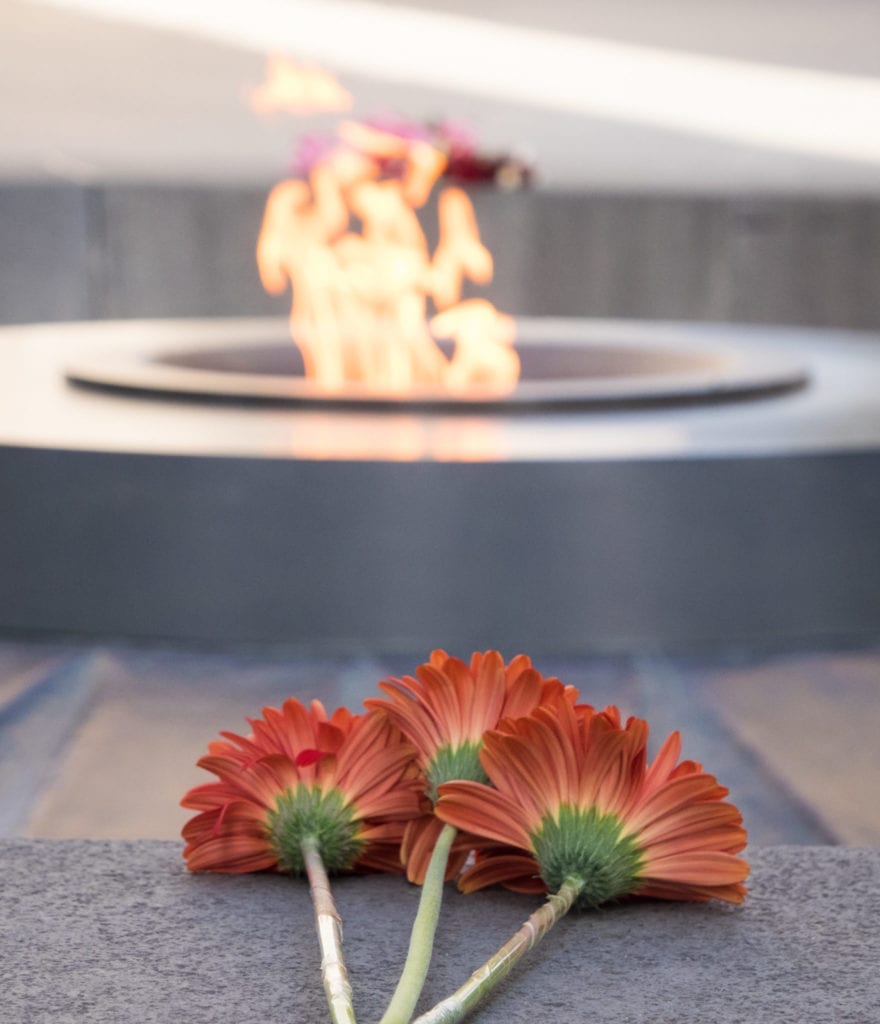
And I made one special stop before leaving Yerevan. I visited the Armenian Genocide Memorial and placed three flowers on behalf of my friend Alexa. Her great-grandmother fled the genocide and survived the death march but lost most of her family.
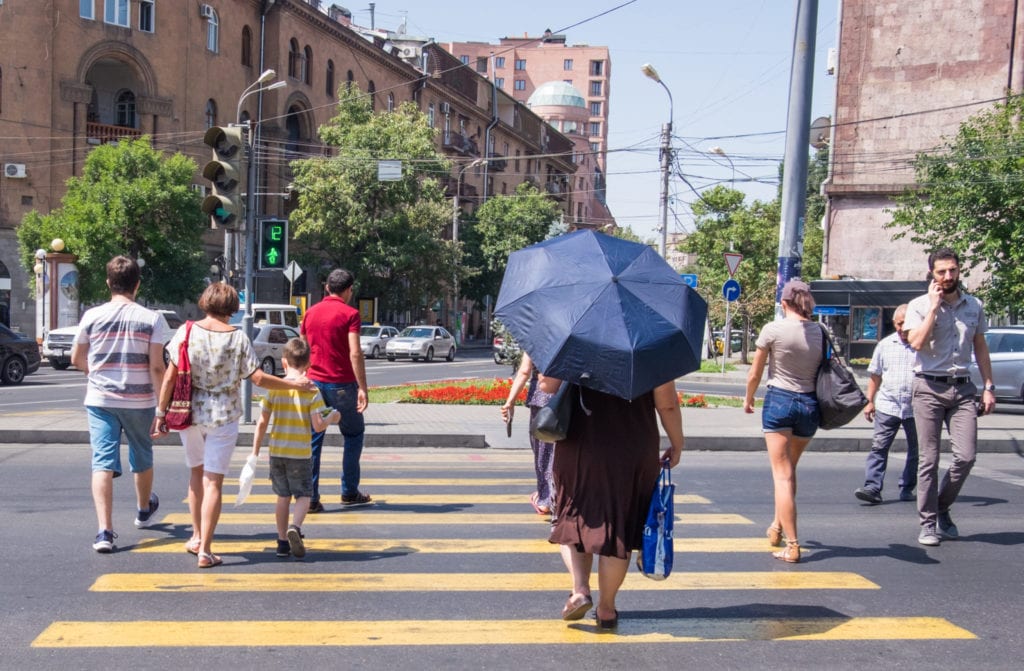
A Recent Armenian Revolution
And there’s a lot of hope buzzing in the streets of Yerevan. Armenia had a revolution in 2018! (Did you even hear about it? I had no clue.)
This peaceful revolution was huge, in fact. Shortly after President Serzh Sargsyan of the Republican Party began his third term as Prime Minister on April 18, 2018, going back on his pledge not to serve a third term, protests led by opposition leader Nikol Pashinyan filled the streets of Yerevan.
Pashinyan was arrested on April 22, spent a night in jail, and the next day Sargsyan resigned. On April 28, all opposition parties supported Pashinyan’s candidacy; on May 8, he was elected Prime Minister.
Seriously. All that happened in less than a month — and major political change was achieved peacefully.
Pashinyan, a charismatic populist leader, was an anti-corruption journalist prior to his political career. It’s a very exciting time in Armenia — you can feel the electricity in the streets.
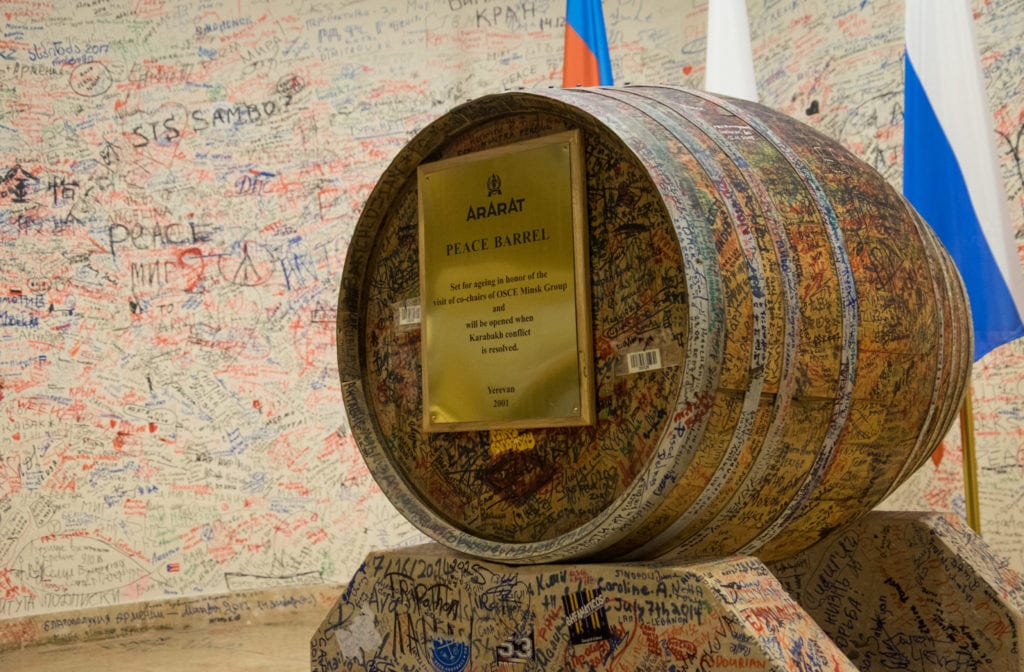
Closed borders to Turkey and Azerbaijan
A Georgian wryly told me, “In Georgia, we say our best neighbor is Black Sea.” Well, Armenia doesn’t even have a sea. There are closed borders to Turkey and Azerbaijan and open borders to Georgia and Iran.
Armenia’s relationship with Azerbaijan is particularly contentious, and much of it relates to the region of Artsakh (Nagorno-Karabakh), which is part of Azerbaijan and currently occupied by Armenia. Neither country will be thrilled you visited the other.
If you’re planning to visit both Armenia and Azerbaijan in the same trip, I strongly urge you to visit Azerbaijan first. Both countries will interrogate you about your past visit, but I’ve heard the Azerbaijanis will interrogate you much worse.
Do note that if you visit Artsakh/Nagorno-Karabakh, you will be refused entry to Azerbaijan. Another good reason to visit Azerbaijan first. My friend Megan has written about the region here.
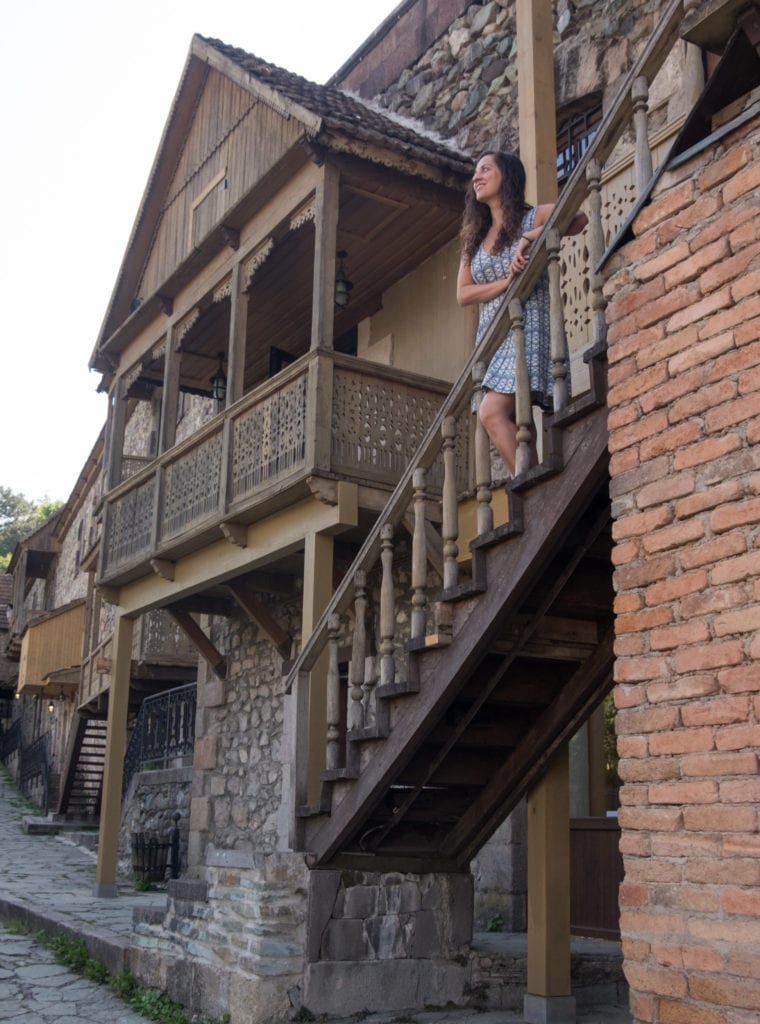
Travel to Armenia with JayWay Travel
I traveled to Armenia as a guest of JayWay Travel, a bespoke travel agency specializing in Central and Eastern Europe. I’ve worked with JayWay Travel for trips to Ukraine in 2017 and the Caucasus in 2019, and both were wonderful experiences. JayWay added Armenia as a destination in 2018.
JayWay builds custom trips to destinations and organizes your trip in full, arranging hotels, transportation, special experiences, and guides along the way. They also give you a SIM card or even a cell phone so you can stay in touch easily.
Not all travelers need that amount of trip planning — but the best thing that JayWay does is make developing, low-infrastructure countries like Armenia easier to handle. For example, public transportation in Armenia is mainly by marshrutka, or shared minibus, but JayWay will arrange a private driver to take you from sight to sight.
JayWay also sets you up with excellent local guides throughout your trip, including a contact in Armenia who runs your trip. Our guide was a guy my age named Karen (“Everyone sees my name and assumes I’m a woman,” he joked) who brought so much passion and love for his country.
The guides handle so much of the day-to-day in Armenia. They’re accustomed to what Americans expect for customer service (and Armenia really isn’t there yet in terms of service).
Some of the other advantages of traveling to Armenia with JayWay: they handle things like adding in stopovers between destinations, making local recommendations, showing off the local food specialties (like the crayfish kebab in Sevan), and handling any troubleshooting you need along the way.
Let me put it this way — while I would have been comfortable traveling independently in Armenia, most casual travelers I know would struggle a bit. I wouldn’t feel comfortable with someone new to traveling in developing countries, like my parents, traveling in Armenia independently, but I would feel very comfortable if they were traveling Armenia with JayWay.
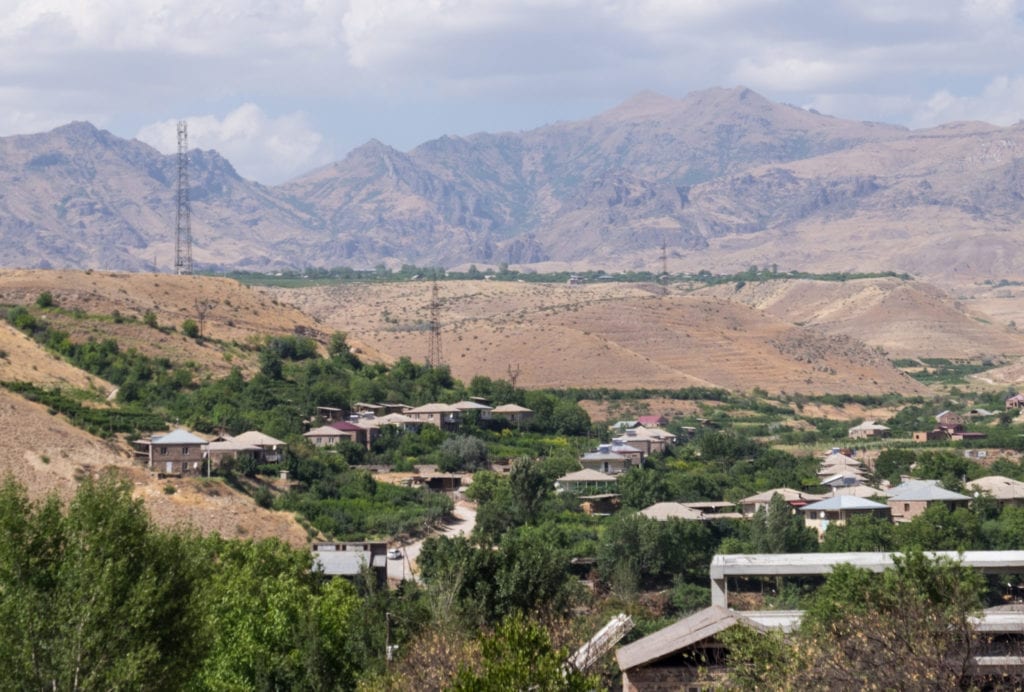
What’s next for Armenia travel?
Armenia is at the dawn of tourism, on the verge of something big. I don’t feel a desperate “Go now, before it changes!” that I did in Georgia. Definitely go — but know that Armenia’s got a long way to come. You won’t have to worry about overtourism here for quite some time.
For that reason, know that the tourism infrastructure is limited here. While an expert traveler would have no qualms about traveling Armenia independently, Armenia would be challenging for people new to developing countries. In that case, traveling with JayWay is perfect for Armenia.
This is a country that very much needs your tourism and will only continue to grow and change. Recently RyanAir announced that they will begin flights to Armenia in January 2020 — to Yerevan and Gyumri. Hopefully this will bring more tourists to Armenia.
I look forward to this country’s promising future.
READ NEXT:
24 Reasons to Travel to Georgia
What’s it Like to Travel to Baku, Azerbaijan?
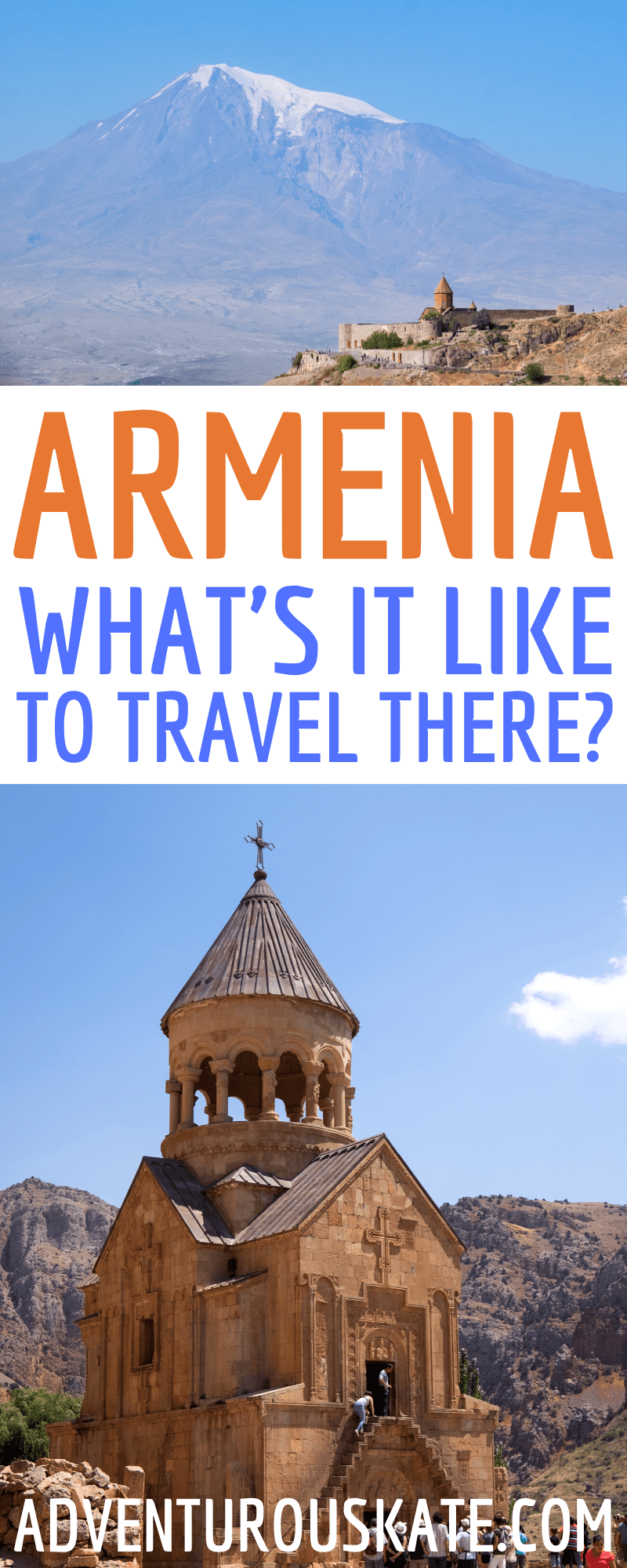
Essential Info
This trip was organized by JayWay Travel, a custom private tour operator specializing in Central and Eastern Europe. JayWay plans bespoke trips and I highly recommend them, especially for making travel smoother sailing in developing countries like Armenia.
I recommend getting an Armenia guidebook because there isn’t a lot of information online in Armenia. Lonely Planet Georgia, Armenia and Azerbaijan is great. I recommend buying the digital version direct from Lonely Planet and keeping the PDF on your phone. (I love my Kindle but hate using the Kindle for guidebooks.)
I highly recommend learning about the Armenian Genocide before visiting Armenia. Jonathan Van Ness’s podcast Getting Curious has an episode about the Armenian Genocide with Dr. Richard Hovanissian. There is a longer, more in-depth podcast about the Armenian Genocide called The Great Crime.
Additionally, Chris Bohjalian has a novel about the genocide called The Sandcastle Girls. Two other popular books are Karnig Parnian’s memoir Goodbye, Antoura and Ronald Grigor Suny’s The Can Live in the Desert but Nowhere Else: A History of the Armenian Genocide.
In Yerevan I stayed at Tufenkian Historic Yerevan Hotel. It’s very comfortable and in a great location, right off a park and a short walk from Republic Square. Rates from $76. You can see all Yerevan hotels here.
In Dilijan I stayed at Tufenkian Old Hotel Complex, which is one of the most photogenic old buildings in Dilijan. It was a very comfortable hotel and I loved the decor. Unfortunately, the beauty of the building means some tourists will line up for selfies on your balcony. Rates from $59. You can see all Dilijan hotels here.
Travel insurance is vital for trips to Armenia — it will protect your health and finances when you have an emergency. For trips to the Caucasus, I use and recommend World Nomads travel insurance.
Does Armenia look like your kind of destination? Share away!